The various taxonomic levels (namely, genera, classes, etc.) of the
hierarchical classification system differ from each other on the basis
of
A) how widely the organisms assigned to each are distributed
throughout the environment.
B) their inclusiveness.
C) the
relative genome sizes of the organisms assigned to each.
D)
morphological characters that are applicable to all organisms.
B) their inclusiveness.
Linnaeus was a "fixist" who believed that species remained
fixed in the form in which they had been created. Linnaeus would have
been uncomfortable with
A) classifying organisms using the
morphospecies concept.
B) the scientific discipline known as
taxonomy.
C) phylogenies.
D) nested, ever-more inclusive
categories of organisms.
E) a hierarchical classification scheme.
C) phylogenies.
Which of the following is (are) problematic when the goal is to
construct phylogenies that accurately reflect evolutionary history?
A) polyphyletic taxa
B) paraphyletic taxa
C)
monophyletic taxa
D) Two of the responses are correct.
D) Two of the responses are correct.
Which individual would make the worst systematist? One who is
uncomfortable with the
A) Linnaean system of classification.
B) notion of hypothetical phylogenies.
C) PhyloCode method
of classification.
D) notion of permanent polytomies
B) notion of hypothetical phylogenies.
The best classification system is that which most closely
A)
unites organisms that possess similar morphologies.
B) conforms
to traditional, Linnaean taxonomic practices.
C) reflects
evolutionary history.
D) reflects the basic separation of
prokaryotes from eukaryotes.
C) reflects evolutionary history.
Which of the following pairs are the best examples of homologous
structures?
A) bones in the bat wing and bones in the human
forelimb
B) owl wing and hornet wing
C) bat wing and bird
wing
D) eyelessness in the Australian mole and eyelessness in
the North American mole
A) bones in the bat wing and bones in the human forelimb
Some molecular data place the giant panda in the bear family
(Ursidae) but place the lesser panda in the raccoon family
(Procyonidae). Consequently, the morphological similarities of these
two species are probably due to
A) inheritance of acquired
characteristics.
B) sexual selection.
C) inheritance of
shared derived characters.
D) possession of analogous
structures.
E) possession of shared primitive characters.
D) possession of analogous structures.
The importance of computers and of computer software to modern
cladistics is most closely linked to advances in
A) light
microscopy.
B) radiometric dating.
C) fossil discovery
techniques.
D) Linnaean classification.
E) molecular genetics.
E) molecular genetics.
Which mutation should least require realignment of homologous regions
of a gene that is common to several related species?
A)
three-base insertion
B) one-base substitution
C) four-base
insertion
D) one-base deletion
E) three-base deletion
B) one-base substitution
Which of the following is true of all horizontally oriented
phylogenetic trees, where time advances to the right?
A) Each
branch point represents a point in absolute time.
B) Organisms
represented at the base of such trees are descendants of those
represented at higher levels.
C) The fewer branch points that
occur between two taxa, the more divergent their DNA sequences should
be.
D) The common ancestor represented by the rightmost branch
point existed more recently in time than the common ancestors
represented at branch points located to the left.
E) The more
branch points there are, the fewer taxa are likely to be represented.
D) The common ancestor represented by the rightmost branch point existed more recently in time than the common ancestors represented at branch points located to the left.
When using a cladistic approach to systematics, which of the
following is considered most important for classification?
A)
shared primitive characters
B) analogous primitive characters
C) shared derived characters
D) the number of homoplasies
E) overall phenotypic similarity
C) shared derived characters
Cladograms (a type of phylogenetic tree) constructed from evidence
from molecular systematics are based on similarities in
A)
morphology.
B) the pattern of embryological development.
C) biochemical pathways.
D) habitat and lifestyle choices.
E) mutations to homologous genes.
E) mutations to homologous genes.
There is some evidence that reptiles called cynodonts may have had
whisker-like hairs around their mouths. If true, then what can be
properly said of hair?
A) It is a shared derived character of
mammals, even if cynodonts continue to be classified as reptiles.
B) It is a shared derived character of the amniote clade, and
not of the mammal clade.
C) It is a shared ancestral character
of the amniote clade, but only if cynodonts are reclassified as
mammals.
D) It is a shared derived character of the mammals, but
only if cynodonts are reclassified as mammals.
D) It is a shared derived character of the mammals, but only if cynodonts are reclassified as mammals.
A researcher wants to determine the genetic relatedness of several
breeds of dog (Canis lupus familiaris). The researcher should compare
homologous sequences of this type of biochemical________which can be
described as ________.
A) fatty acids; highly conserved
B) lipids; poorly conserved
C) proteins; highly conserved
D) amino acids; highly conserved
E) nucleic acids, poorly conserved
E) nucleic acids, poorly conserved
Species that are not closely related and that do not share many
anatomical similarities can still be placed together on the same
phylogenetic tree by comparing their
A) plasmids.
B)
mitochondrial genomes.
C) homologous genes that are poorly
conserved.
D) homologous genes that are highly conserved.
D) homologous genes that are highly conserved.
The lakes of northern Minnesota are home to many similar species of
damselflies of the genus Enallagma that have apparently undergone
speciation from ancestral stock since the last glacial retreat about
10,000 years ago. Sequencing which of the following would probably be
most useful in sorting out evolutionary relationships among these
closely related species?
A) nuclear DNA
B) mitochondrial
DNA
C) small nuclear RNA
D) ribosomal RNA
E) amino
acids in proteins
B) mitochondrial DNA
What important criterion was used in the late 1960s to distinguish
between the three multicellular eukaryotic kingdoms of the
five-kingdom classification system?
A) the number of cells
present in individual organisms
B) the geological stratum in
which fossils first appear
C) the nutritional modes they employ
D) the biogeographic province where each first appears
E)
the features of their embryos
C) the nutritional modes they employ
Which eukaryotic kingdom is polyphyletic, and therefore unacceptable,
based on cladistics?
A) Plantae
B) Fungi
C) Animalia
D) Protista
E) Monera
D) Protista
A large proportion of archaeans are extremophiles, so called because
they inhabit extreme environments with high acidity, salinity, and/or
temperature. Such environments are thought to have been much more
common on the primitive Earth. Thus, modern extremophiles survive only
in places that their ancestors became adapted to long ago. Which of
the following is, consequently, a valid statement about modern
extremophiles, assuming that their habitats have remained relatively
unchanged?
A) Among themselves, they should share relatively few
ancestral traits, especially those that enabled ancestral forms to
adapt to extreme conditions.
B) On a phylogenetic tree whose
branch lengths are proportional to the amount of genetic change, the
branches of the extremophiles should be shorter than the
non-extremophilic archaeans.
C) They should contain genes that
originated in eukaryotes that are the hosts for numerous species of
bacteria.
D) They should currently be undergoing a high level of
horizontal gene transfer with non-extremophilic archaeans.
On a phylogenetic tree whose branch lengths are proportional to the amount of genetic change, the branches of the extremophiles should be shorter than the non-extremophilic archaeans.
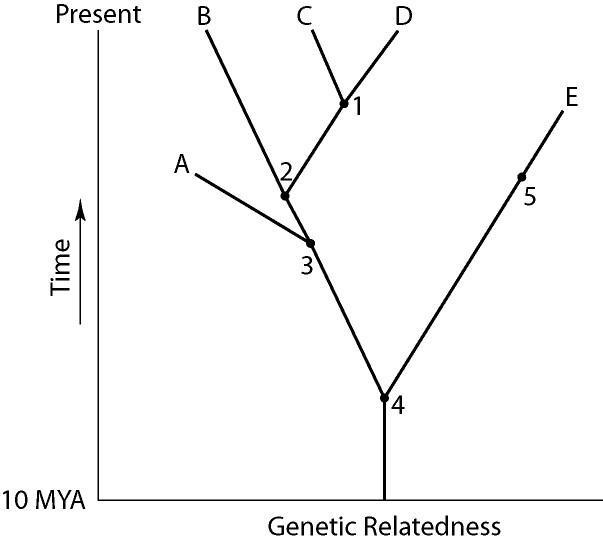
Which extinct species should be the best candidate to serve as the
outgroup for the clade whose common ancestor occurs at position 2 in
Figure 26.1?
A) A
B) B
C) C
D) D
E) E
A) A
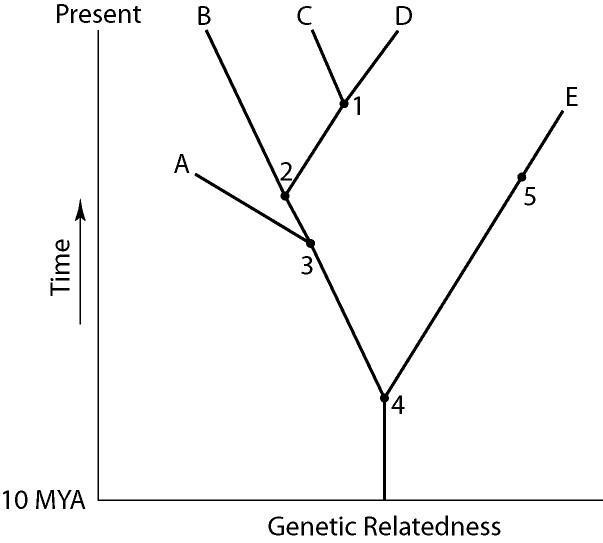
If Figure 26.1 is an accurate depiction of relatedness, then which of
the following should be correct?
1. The entire tree is
based on maximum parsimony.
2. If all species depicted here
make up a taxon, this taxon is monophyletic.
3. The last common
ancestor of species B and C occurred more recently than the last
common ancestor of species D and E.
4. Species A is the direct
ancestor of both species B and species C.
5. The species
present at position 3 is ancestral to C, D, and E.
A) 1 and 3
B) 3 and 4
C) 2, 3, and 4
D) 1, 2, and 3
D) 1, 2, and 3
Traditionally, whales and hippopotamuses have been classified in
different orders, the Cetacea and the Artiodactyla, respectively.
Recent molecular evidence, however, indicates that the whales' closest
living relatives are the hippos. This has caused some zoologists to
lump the two orders together into a single clade, the Cetartiodactyla.
There is no consensus on whether the Cetartiodactyla should be
accorded order status or superorder status. This is because it remains
unclear whether the whale lineage diverged from the lineage leading to
the hippos before or after the other members of the order Artiodactyla
(pigs, camels, etc.) diverged (see Figure 26.2).
Figure
26.2 contrasts the "Within the artiodactyls" origin of the
whale lineage with the "Without the artiodactyls" origin of
the whale lineage
If it turns out that the whale
lineage diverged from the lineage leading to hippos after the
divergence of the lineage leading to the pigs and other artiodactyls,
and if the whales continue to be classified in the order Cetacea,
then what becomes true of the order Artiodactyla?
A) It becomes monophyletic.
B) It becomes paraphyletic.
C) It becomes polyphyletic.
D) It is incorporated into the
order Cetacea
B) It becomes paraphyletic.
Traditionally, whales and hippopotamuses have been classified in
different orders, the Cetacea and the Artiodactyla, respectively.
Recent molecular evidence, however, indicates that the whales' closest
living relatives are the hippos. This has caused some zoologists to
lump the two orders together into a single clade, the Cetartiodactyla.
There is no consensus on whether the Cetartiodactyla should be
accorded order status or superorder status. This is because it remains
unclear whether the whale lineage diverged from the lineage leading to
the hippos before or after the other members of the order Artiodactyla
(pigs, camels, etc.) diverged (see Figure 26.2).
Figure
26.2 contrasts the "Within the artiodactyls" origin of the
whale lineage with the "Without the artiodactyls" origin of
the whale lineage
If it turns out that the whale lineage
diverged from the lineage leading to hippos after the divergence of
the lineage leading to the pigs and other artiodactyls, and if the
whales continue to be classified in the order Cetacea, then what
becomes true of the taxon Cetartiodactyla?
A) It should be considered as one monophyletic order.
B) It
should be considered a superorder that consists of two monophyletic
orders.
C) It should be established as a paraphyletic order.
D) It should be thrown out or modified by taxonomists if
classification is to reflect evolutionary history.
It should be considered as one monophyletic order.
Traditionally, whales and hippopotamuses have been classified in
different orders, the Cetacea and the Artiodactyla, respectively.
Recent molecular evidence, however, indicates that the whales' closest
living relatives are the hippos. This has caused some zoologists to
lump the two orders together into a single clade, the Cetartiodactyla.
There is no consensus on whether the Cetartiodactyla should be
accorded order status or superorder status. This is because it remains
unclear whether the whale lineage diverged from the lineage leading to
the hippos before or after the other members of the order Artiodactyla
(pigs, camels, etc.) diverged (see Figure 26.2).
Figure
26.2 contrasts the "Within the artiodactyls" origin of the
whale lineage with the "Without the artiodactyls" origin of
the whale lineage
One morphological feature of modern
cetaceans is a vestigial pelvic girdle. If it is determined that
cetacean lineage diverged from the artiodactyls' lineage after the
divergence of pigs and other artiodactyla, then what should be true
of the vestigial pelvic girdle of cetaceans?
A) It should be considered a shared ancestral character of the
cetartiodactyls.
B) It should be considered a shared derived
character of the cetartiodactyls.
C) It should be considered a
shared ancestral character of the cetaceans.
D) It should be
considered a shared derived character of the cetaceans.
D) It should be considered a shared derived character of the cetaceans
Traditionally, whales and hippopotamuses have been classified in
different orders, the Cetacea and the Artiodactyla, respectively.
Recent molecular evidence, however, indicates that the whales' closest
living relatives are the hippos. This has caused some zoologists to
lump the two orders together into a single clade, the Cetartiodactyla.
There is no consensus on whether the Cetartiodactyla should be
accorded order status or superorder status. This is because it remains
unclear whether the whale lineage diverged from the lineage leading to
the hippos before or after the other members of the order Artiodactyla
(pigs, camels, etc.) diverged (see Figure 26.2).
Figure
26.2 contrasts the "Within the artiodactyls" origin of the
whale lineage with the "Without the artiodactyls" origin of
the whale lineage
It was once thought that cetaceans had
evolved from an extinct group of mammals called the mesonychids. If,
in the future, it is determined that some organisms currently
classified as cetaceans did actually evolve from mesonychids, whereas
other cetaceans evolved from artiodactyl stock, then what will be
true of the order Cetacea?
A) It will be paraphyletic.
B)
It will be polyphyletic.
C) It will need to be thrown out or
modified if classification is to reflect evolutionary history.
D) Two of the responses are correct.
D) Two of the responses are correct.
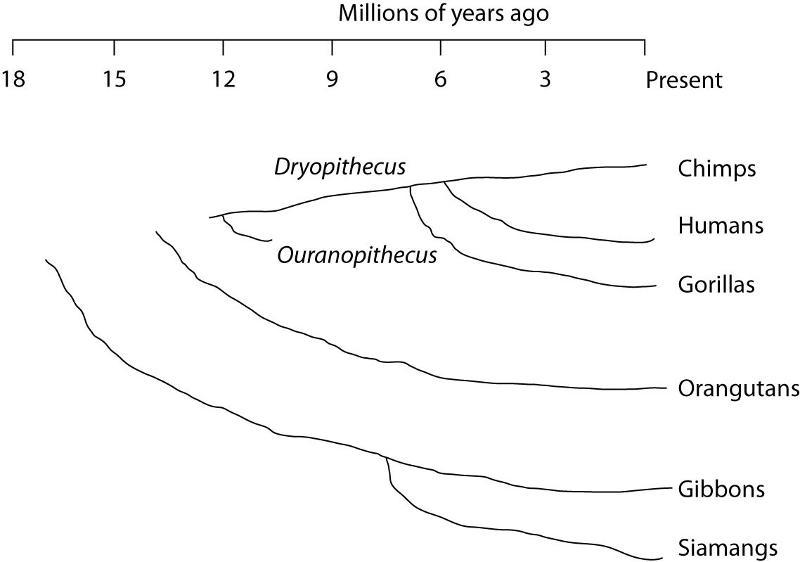
Figure 26.5. Humans, chimpanzees, gorillas, and orangutans are
members of a clade called the great apes, which shared a common
ancestor about 18 million years ago (Figure 26.4). Gibbons and
siamangs comprise a clade called the lesser apes. Tree-branch lengths
indicate elapsed time.
The great apes comprise the
family Hominidae, whereas the lesser apes comprise the family
Hylobatidae. If the extant organisms on the far right side of Figure
26.5 comprise the next-most exclusive (i.e., specific) taxon, then
they comprise different
A) subspecies.
B) species.
C) genuses.
D) genera.
E) orders.
D) genera.
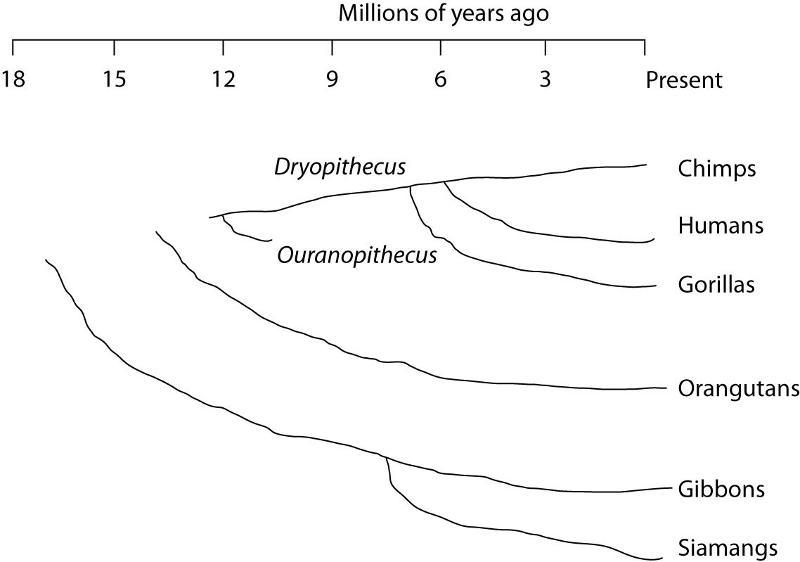
Figure 26.5. Humans, chimpanzees, gorillas, and orangutans are
members of a clade called the great apes, which shared a common
ancestor about 18 million years ago (Figure 26.4). Gibbons and
siamangs comprise a clade called the lesser apes. Tree-branch lengths
indicate elapsed time.
Assuming chimps and gorillas are
humans' closest relatives, removing humans from the great ape clade
and placing them in a different clade has the effect of making the
phylogenetic tree of the great apes
A) polyphyletic.
B)
paraphyletic.
C) monophyletic.
D) conform with Linnaeus'
view of great ape phylogeny.
B) paraphyletic.
Traditionally, zoologists have placed birds in their own class, Aves.
More recently, molecular evidence has shown that birds are more
closely related to reptiles than their anatomy reveals. Genetically,
birds are more closely related to crocodiles than crocodiles are to
turtles. Thus, bird anatomy has become highly modified as they have
adapted to flight, without their genes having undergone nearly as much
change.
62) Taxonomically, what should be done with the
birds?
A) The traditional stance is correct. Such dramatic
morphological change as undergone by birds merits that the birds be
placed in their own order, separate from the reptiles.
B) The
birds should be reclassified, and their new taxon should be the
subclass Aves. Genetic similarity trumps morphological dissimilarity.
C) The rest of the reptiles should be reclassified as a
subclass within the class Aves.
D) Science is consensual.
Taxonomy is a science. Variant classification schemes involving the
birds should be tolerated until consensus is reached.
D) Science is consensual. Taxonomy is a science. Variant classification schemes involving the birds should be tolerated until consensus is reached.
Traditionally, zoologists have placed birds in their own class, Aves.
More recently, molecular evidence has shown that birds are more
closely related to reptiles than their anatomy reveals. Genetically,
birds are more closely related to crocodiles than crocodiles are to
turtles. Thus, bird anatomy has become highly modified as they have
adapted to flight, without their genes having undergone nearly as much
change.
64) For a proponent of PhyloCode classification,
what is true of the reptile clade if birds are not included in it?
A) It becomes paraphyletic and, thus, an invalid reflection of
evolutionary history.
B) It becomes a subclass, instead of a
class.
C) It becomes a superclass, whereas the birds remain a
class.
D) PhyloCode does not concern itself with what is, or is
not, a clade.
A) It becomes paraphyletic and, thus, an invalid reflection of evolutionary history.
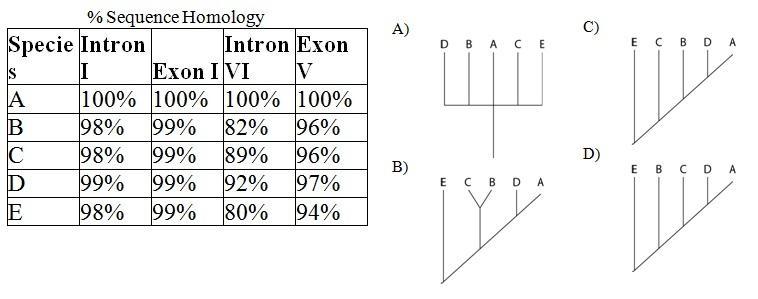
The next question refer to the following table, which compares the %
sequence homology of four different parts (two introns and two exons)
of a gene that is found in five different eukaryotic species. Each
part is numbered to indicate its distance from the promoter (e.g.,
Intron I is the one closest to the promoter). The data reported for
species A were obtained by comparing DNA from one member of species A
to another member of species A.
65) Based on the tabular
data, and assuming that time advances vertically, which cladogram (a
type of phylogenetic tree) is the most likely depiction of the
evolutionary relationships among these five species?
A.
SEE IMAGE
B. SEE IMAGE
C. SEE IMAGE
D. SEE IMAGE
D. SEE IMAGE (E B C D A)
Three living species X, Y, and Z share a common ancestor T, as do
extinct species U and V. A grouping that consists of species T, X, Y,
and Z (but not U or V) makes up
A) a valid taxon.
B) a
monophyletic clade.
C) an ingroup, with species U as the
outgroup.
D) a paraphyletic group.
E) a polyphyletic group.
E) a polyphyletic group.
In a comparison of birds and mammals, having four limbs is
A) a
shared ancestral character.
B) a shared derived character.
C) a character useful for distinguishing birds from mammals.
D) an example of analogy rather than homology.
E) a
character useful for sorting bird species.
A) a shared ancestral character.
To apply parsimony to constructing a phylogenetic tree,
A)
choose the tree that assumes all evolutionary changes are equally
probable.
B) choose the tree in which the branch points are
based on as many shared derived characters as possible.
C) base
phylogenetic trees only on the fossil record, as this provides the
simplest explanation for evolution.
D) choose the tree that
represents the fewest evolutionary changes, either in DNA sequences or
morphology.
E) choose the tree with the fewest branch points.
D) choose the tree that represents the fewest evolutionary changes, either in DNA sequences or morphology.
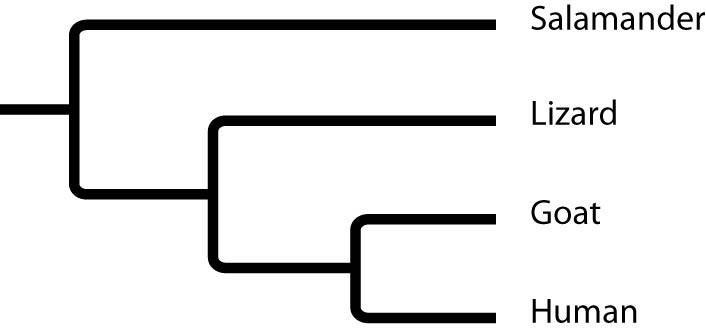
72) Based on this tree, which statement is not correct?
A) The salamander lineage is a basal taxon.
B) Salamanders
are a sister group to the group containing lizards, goats, and humans.
C) Salamanders are as closely related to goats as to humans.
D) Lizards are more closely related to salamanders than to humans.
D) Lizards are more closely related to salamanders than to humans.
Mycoplasmas are bacteria that lack cell walls. On the basis of this
structural feature, which statement concerning mycoplasmas should be
true?
A) They are gram-negative.
B) They are subject to
lysis in hypotonic conditions.
C) They lack a cell membrane as
well.
D) They should contain less cellulose than do bacteria
that possess cell walls.
E) They possess typical prokaryotic flagella.
B) They are subject to lysis in hypotonic conditions.
Though plants, fungi, and prokaryotes all have cell walls, we place
them in different taxa. Which of these observations comes closest to
explaining the basis for placing these organisms in different taxa,
well before relevant data from molecular systematics became available?
A) Some closely resemble animals, which lack cell walls.
B)
Their cell walls are composed of very different biochemicals.
C)
Some have cell walls only for support.
D) Some have cell walls
only for protection from herbivores.
E) Some have cell walls
only to control osmotic balance.
B) Their cell walls are composed of very different biochemicals.
The predatory bacterium, Bdellovibrio bacteriophorus, drills into a
prey bacterium and, once inside, digests it. In an attack upon a
gram-negative bacterium that has a slimy cell covering, what is the
correct sequence of structures penetrated by B. bacteriophorus on its
way to the prey's cytoplasm?
1. membrane composed mostly of lipopolysaccharide
2.
membrane composed mostly of phospholipids
3. peptidoglycan
4. capsule
A) 2, 4, 3, 1
B) 1, 3, 4, 2
C) 1, 4, 3, 2
D)
4, 1, 3, 2
E) 4, 3, 1, 2
D) 4, 1, 3, 2
In a bacterium that possesses antibiotic resistance and the potential
to persist through very adverse conditions, such as freezing, drying,
or high temperatures, DNA should be located within, or be part of,
which structures?
1. nucleoid region
2. endospore
3.
fimbriae
4. plasmids
A) 1 only
B) 1 and 2 only
C) 1 and 4 only
D) 2
and 4 only
E) 1, 2, and 4
E) 1, 2, and 4
Which two structures play direct roles in permitting bacteria to
adhere to each other, or to other surfaces?
1. capsules
2.
endospores
3. fimbriae
4. plasmids
5. flagella
A) 1 and 2
B) 1 and 3
C) 2 and 3
D) 3 and 4
E) 3 and 5
B) 1 and 3
The typical prokaryotic flagellum features
A) an internal 9 + 2
pattern of microtubules.
B) an external covering provided by the
plasma membrane.
C) a complex "motor" embedded in the
cell wall and plasma membrane.
D) a basal body that is similar
in structure to the cell's centrioles.
E) a membrane-enclosed
organelle with motor proteins.
C) a complex "motor" embedded in the cell wall and plasma membrane.
Which of the following is an important source of endotoxin in
gram-negative species?
A) endospore
B) sex pilus
C)
flagellum
D) cell wall
E) capsule
D) cell wall
Which of these statements about prokaryotes is correct?
A)
Bacterial cells conjugate to mutually exchange genetic material.
B) Their genetic material is confined within vesicles known as
plasmids.
C) They divide by binary fission, without mitosis or
meiosis.
D) The persistence of bacteria throughout evolutionary
time is due to their genetic homogeneity (in other words, sameness).
E) Genetic variation in bacteria is not known to occur, because
of their asexual mode of reproduction.
C) They divide by binary fission, without mitosis or meiosis.
Carl Woese and collaborators identified two major branches of
prokaryotic evolution. What was the basis for dividing prokaryotes
into two domains?
A) microscopic examination of staining
characteristics of the cell wall
B) metabolic characteristics
such as the production of methane gas
C) metabolic
characteristics such as chemoautotrophy and photosynthesis
D)
genetic characteristics such as ribosomal RNA sequences
E)
ecological characteristics such as the ability to survive in extreme environments
D) genetic characteristics such as ribosomal RNA sequences
Which statement about the domain Archaea is true?
A) Genetic
prospecting has recently revealed the existence of many previously
unknown archaean species.
B) No archaeans can reduce CO₂ to
methane.
C) The genomes of archaeans are unique, containing no
genes that originated within bacteria.
D) No archaeans can
inhabit solutions that are nearly 30% salt.
E) No archaeans are
adapted to waters with temperatures above the boiling point.
A) Genetic prospecting has recently revealed the existence of many previously unknown archaean species.
Which of the following traits do archaeans and bacteria share?
1. composition of the cell wall
2. presence of plasma
membrane
3. lack of a nuclear envelope
4. identical rRNA
sequences
A) 1 only
B) 3 only
C) 1 and 3
D) 2 and 3
E) 2 and 4
D) 2 and 3
A fish that has been salt-cured subsequently develops a reddish
color. You suspect that the fish has been contaminated by the extreme
halophile, Halobacterium. Which of these features of cells removed
from the surface of the fish, if confirmed, would support your
suspicion?
1. the presence of the same photosynthetic pigments
found in cyanobacteria
2. cell walls that lack peptidoglycan
3. cells that are isotonic to conditions on the surface of the
fish
4. cells containing bacteriorhodopsin
5. the presence
of very large numbers of ion pumps in its plasma membrane
A) 2 and 5
B) 3 and 4
C) 1, 4, and 5
D) 3, 4,
and 5
E) 2, 3, 4, and 5
E) 2, 3, 4, and 5
If all prokaryotes on Earth suddenly vanished, which of the following
would be the most likely and most direct result?
A) The number
of organisms on Earth would decrease by 1020%.
B) Human
populations would thrive in the absence of disease.
C)
Bacteriophage numbers would dramatically increase.
D) The
recycling of nutrients would be greatly reduced, at least initially.
E) There would be no more pathogens on Earth.
The recycling of nutrients would be greatly reduced, at least initially.
In general, what is the primary ecological role of prokaryotes?
A) parasitizing eukaryotes, thus causing diseases
B)
breaking down organic matter
C) metabolizing materials in
extreme environments
D) adding methane to the atmosphere
E) serving as primary producers in terrestrial environments
B) breaking down organic matter
In a hypothetical situation, a bacterium lives on the surface of a
leaf, where it obtains nutrition from the leaf's nonliving, waxy
covering while inhibiting the growth of other microbes that are plant
pathogens. If this bacterium gains access to the inside of a leaf,
however, it causes a fatal disease in the plant. Once the plant dies,
the bacterium and its offspring decompose the plant. What is the
correct sequence of ecological roles played by the bacterium in the
situation described here? Use only those that apply.
1. nutrient
recycler
2. mutualist
3. commensal
4.parasite
5. primary producer
A) 1, 3, 4
B) 2, 3, 4
C) 2, 4, 1
D) 1, 2, 5
E) 1, 2, 3
C) 2, 4, 1
Broad-spectrum antibiotics inhibit the growth of most intestinal
bacteria. Consequently, assuming that nothing is done to counter the
reduction of intestinal bacteria, a hospital patient who is receiving
broad-spectrum antibiotics is most likely to become
A) unable to
fix carbon dioxide.
B) antibiotic resistant.
C) unable to
fix nitrogen.
D) unable to synthesize peptidoglycan.
E)
deficient in certain vitamins and nutrients.
E) deficient in certain vitamins and nutrients.
Figure 27.2 depicts changes to the amount of DNA present in a
recipient cell that is engaged in conjugation with an Hfr cell. Hfr
cell DNA begins entering the recipient cell at Time A. Assume that
reciprocal crossing over occurs (in other words, a fragment of the
recipient's chromosome is exchanged for a homologous fragment from the
Hfr cell's DNA). Use Figure 27.2 to answer the following question.
Figure 27.2
46) What is occurring at Time C that is decreasing the DNA
content?
A) crossing over
B) cytokinesis
C) meiosis
D) degradation of DNA that was not retained in the recipient's
chromosome
E) reversal of the direction of conjugation
D) degradation of DNA that was not retained in the recipient's chromosome
Figure 27.2 depicts changes to the amount of DNA present in a
recipient cell that is engaged in conjugation with an Hfr cell. Hfr
cell DNA begins entering the recipient cell at Time A. Assume that
reciprocal crossing over occurs (in other words, a fragment of the
recipient's chromosome is exchanged for a homologous fragment from the
Hfr cell's DNA). Use Figure 27.2 to answer the following question.
Figure 27.2
47) How is the recipient cell different at Time D than it was at
Time A?
A) It has a greater number of genes.
B) It has a
greater mass of DNA.
C) It has a different sequence of base
pairs.
D) It contains bacteriophage DNA.
E) Its
membrane-bound DNA pumps are inactive
C) It has a different sequence of base pairs.
Figure 27.2 depicts changes to the amount of DNA present in a
recipient cell that is engaged in conjugation with an Hfr cell. Hfr
cell DNA begins entering the recipient cell at Time A. Assume that
reciprocal crossing over occurs (in other words, a fragment of the
recipient's chromosome is exchanged for a homologous fragment from the
Hfr cell's DNA). Use Figure 27.2 to answer the following question.
Figure 27.2
48) Which two processes are responsible for the shape of the
curve at Time B?
1. transduction
2. entry of
single-stranded Hfr DNA
3. rolling circle replication of
single-stranded Hfr DNA
4. activation of DNA pumps in plasma
membrane
A) 1 and 2
B) 1 and 4
C) 2 and 3
D) 2 and 4
E) 3 and 4
C) 2 and 3
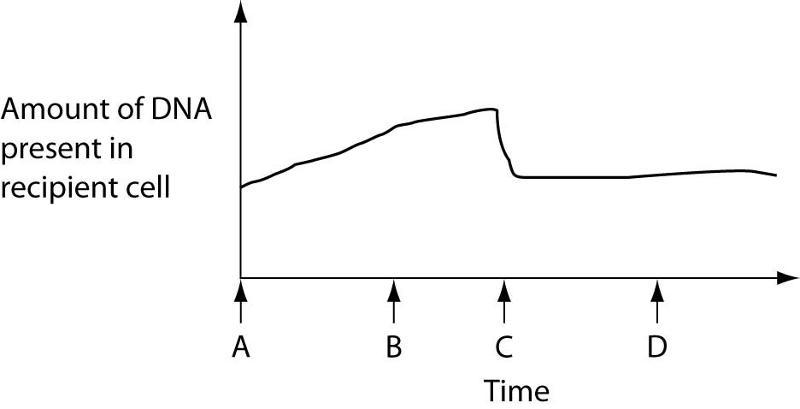
Figure 27.2 depicts changes to the amount of DNA present in a
recipient cell that is engaged in conjugation with an Hfr cell. Hfr
cell DNA begins entering the recipient cell at Time A. Assume that
reciprocal crossing over occurs (in other words, a fragment of the
recipient's chromosome is exchanged for a homologous fragment from the
Hfr cell's DNA). Use Figure 27.2 to answer the following question.
Figure 27.2
49) During which two times can the recipient accurately be
described as "recombinant" due to the sequence of events
portrayed in Figure 27.2?
A) during Times C and D
B)
during Times A and C
C) during Times B and C
D) during
Times A and B
E) during Times B and D
A) during Times C and D
Figure 27.2 depicts changes to the amount of DNA present in a
recipient cell that is engaged in conjugation with an Hfr cell. Hfr
cell DNA begins entering the recipient cell at Time A. Assume that
reciprocal crossing over occurs (in other words, a fragment of the
recipient's chromosome is exchanged for a homologous fragment from the
Hfr cell's DNA). Use Figure 27.2 to answer the following question.
Figure 27.2
50) Which question, arising from the results depicted in Figure
27.2, is most interesting from a genetic perspective, and has the
greatest potential to increase our knowledge base?
A) If
reciprocal crossing over could occur even if the piece of donated Hfr
DNA is identical to the homologous portion of the recipient's
chromosome, what prevents this from occurring?
B) What forces
are generally responsible for disrupting the sex pilus?
C) How
is it that a recipient cell does not necessarily become an Hfr cell as
the result of conjugation with an Hfr cell?
D) What makes a cell
an Hfr cell?
A) If reciprocal crossing over could occur even if the piece of donated Hfr DNA is identical to the homologous portion of the recipient's chromosome, what prevents this from occurring?
A hypothetical bacterium swims among human intestinal contents until
it finds a suitable location on the intestinal lining. It adheres to
the intestinal lining using a feature that also protects it from
phagocytes, bacteriophages, and dehydration. Fecal matter from a human
in whose intestine this bacterium lives can spread the bacterium, even
after being mixed with water and boiled. The bacterium is not
susceptible to the penicillin family of antibiotics. It contains no
plasmids and relatively little peptidoglycan.
53) This bacterium's ability to survive in a human who is taking
penicillin pills may be due to the presence of
1.
penicillin-resistance genes
2. a secretory system that removes
penicillin from the cell
3. a gram-positive cell wall
4. a
gram-negative cell wall
5. an endospore
A) 1 or 5
B) 2 or 3
C) 4 or 5
D) 2, 3, or 5
E) 2, 4, or 5
D) 2, 3, or 5
The following table depicts characteristics of five prokaryotic
species (A—E). Use the information in the table to answer the
following question.
Gram-variable prokaryotes are, sometimes, those without any
peptidoglycan. Which two species are most likely to be archaeans?
A) species A and B
B) species A and C
C) species B
and E
D) species C and D
E) species C and E
A) species A and B
Bacteria perform each of the following ecological roles. Which role
typically does not involve a symbiosis?
A) skin commensalist
B) decomposer
C) aggregates with methane-consuming archaea
D) gut mutualist
E) pathogen
B) decomposer
1) All protists are
A) unicellular.
B) eukaryotic.
C) symbionts.
D) monophyletic.
E) mixotrophic.
B) eukaryotic.
Biologists have long been aware that the defunct kingdom Protista is
polyphyletic. Which of these statements is most consistent with this
conclusion?
A) Many species within this kingdom were once
classified as monerans.
B) Animals, plants, and fungi arose from
different protist ancestors.
C) The eukaryotic condition has
evolved more than once among the protists.
D) Chloroplasts among
various protists are similar to those found in prokaryotes.
E)
Some protists, all animals, and all fungi share a protist common
ancestor, but these protists, animals, and fungi are currently
assigned to three different kingdoms.
C) The eukaryotic condition has evolved more than once among the protists.
According to the endosymbiotic theory of the origin of eukaryotic
cells, how did mitochondria originate?
A) from infoldings of the
plasma membrane, coupled with mutations of genes for proteins in
energy-transfer reactions
B) from engulfed, originally
free-living proteobacteria
C) by secondary endosymbiosis
D) from the nuclear envelope folding outward and forming
mitochondrial membranes
E) when a protoeukaryote engaged in a
symbiotic relationship with a protocell
B) from engulfed, originally free-living proteobacteria
Which two genera have members that can evade the human immune system
by frequently changing their surface proteins?
1. Plasmodium
2. Trichomonas
3. Paramecium
4.
Trypanosoma
5. Entamoeba
A) 1 and 2
B) 1 and 4
C) 2 and 3
D) 2 and 4
E) 4 and 5
B) 1 and 4
Which of the following pairs of protists and their characteristics is
mismatched?
A) apicomplexans–internal parasites
B) golden
algae–planktonic producers
C) euglenozoans–unicellular
flagellates
D) ciliates–red tide organisms
E)
entamoebas–ingestive heterotrophs
D) ciliates–red tide organisms
Which of the following statements about dinoflagellates is true?
A) They possess two flagella.
B) All known varieties are
autotrophic.
C) Their walls are usually composed of silica
plates.
D) Many types lack mitochondria.
E) Their dead
cells accumulate on the seafloor, and are mined to serve as a
filtering material.
A) They possess two flagella.
You are given an unknown organism to identify. It is unicellular and
heterotrophic. It is motile, using many short extensions of the
cytoplasm, each featuring the 9 + 2 filament pattern. It has
well-developed organelles and three nuclei, one large and two small.
This organism is most likely to be a member of which group?
A)
foraminiferans
B) radiolarians
C) ciliates
D)
kinetoplastids
E) slime molds
C) ciliates
A large seaweed that floats freely on the surface of deep bodies of
water would be expected to lack which of the following?
A)
thalli
B) bladders
C) holdfasts
D) gel-forming polysaccharides
C) holdfasts
A snail-like, coiled, porous test (shell) of calcium carbonate is
characteristic of which group?
A) diatoms
B)
foraminiferans
C) radiolarians
D) gymnamoebas
B) foraminiferans
The chloroplasts of land plants are thought to have been derived
according to which evolutionary sequence?
A) cyanobacteria →
green algae → land plants
B) cyanobacteria → green algae → fungi
→ land plants
C) red algae → brown algae → green algae → land
plants
D) cyanobacteria → red algae → green algae → land plants
A) cyanobacteria → green algae → land plants
The chloroplasts of all of the following are thought to be derived
from ancestral red algae, except those of
A) golden algae.
B) diatoms.
C) dinoflagellates.
D) green algae.
E) brown algae.
D) green algae.
A biologist discovers an alga that is marine, multicellular, and
lives at a depth reached only by blue light. This alga probably
belongs to which group?
A) red algae
B) brown algae
C) green algae
D) dinoflagellates
E) golden algae
A) red algae
Green algae differ from land plants in that many green algae
A)
are heterotrophs.
B) are unicellular.
C) have plastids.
D) have alternation of generations.
E) have cell walls
containing cellulose.
B) are unicellular.
If the Archaeplastidae are eventually designated a kingdom, and if
land plants are excluded from this kingdom, then what will be true of
this new kingdom?
A) It will be monophyletic.
B) It will
more accurately depict evolutionary relationships than does the
current taxonomy.
C) It will be paraphyletic.
D) It will
be a true clade.
E) It will be polyphyletic.
C) It will be paraphyletic.
Which of the following statements concerning protists is true?
A) All protists have mitochondria, though in some species they
are much reduced and known by different names.
B) The primary
organism that transmits malaria to humans by its bite is the tsetse
fly.
C) All apicomplexans are autotrophic.
D) All slime
molds have an amoeboid stage that may be followed by a stage during
which spores are produced.
E) Euglenozoans that are mixotrophic
lack functional chloroplasts.
A) All protists have mitochondria, though in some species they are much reduced and known by different names.
Which of the following is correctly described as a primary producer?
A) oomycete
B) kinetoplastid
C) apicomplexan
D) diatom
E) radiolarian
D) diatom
You are given the task of designing an aerobic, mixotrophic protist
that can perform photosynthesis in fairly deep water (for example, 250
m deep), and can also crawl about and engulf small particles. With
which two of the following structures would you provide your protist?
1. hydrogenosome
2. apicoplast
3. pseudopods
4. chloroplast from red alga
5. chloroplast from green
alga
A) 1 and 2
B) 2 and 3
C) 2 and 4
D) 3 and 4
E) 4 and 5
D) 3 and 4
You are given the task of designing an aquatic protist that is a
primary producer. It cannot swim on its own, yet must stay in well-lit
surface waters. It must be resistant to physical damage from wave
action. It should be most similar to a(n)
A) diatom.
B)
dinoflagellate.
C) apicomplexan.
D) red alga.
E) radiolarian.
A) diatom.
A gelatinous seaweed that grows in shallow, cold water and undergoes
heteromorphic alternation of generations is most probably what type of
alga?
A) red
B) green
C) brown
D) yellow
C) brown
Living diatoms contain brownish plastids. If global warming causes
blooms of diatoms in the surface waters of Earth's oceans, how might
this be harmful to the animals that build coral reefs?
A) The
coral animals, which capture planktonic organisms, may be outcompeted
by the diatoms.
B) The coral animals' endosymbiotic
dinoflagellates may get "shaded out" by the diatoms.
C) The coral animals may die from overeating the plentiful
diatoms, with their cases of silica.
D) The diatoms'
photosynthetic output may over-oxygenate the water.
B) The coral animals' endosymbiotic dinoflagellates may get "shaded out" by the diatoms.
Giardia lamblia is an intestinal parasite of humans and other mammals
that causes intestinal ailments in most people who ingest the cysts.
Upon ingestion, each cyst releases two motile cells, called
trophozoites. These attach to the small intestine's lining via a
ventral adhesive disk. The trophozoites anaerobically metabolize
glucose from the host's intestinal contents to produce ATP.
Reproduction is completely asexual, occurring by longitudinal binary
fission of trophozoites, with each daughter cell receiving two,
haploid nuclei (n = 5). A trophozoite will often encyst as it passes
into the large intestine by secreting around itself a case that is
resistant to cold, heat, and dehydration. Infection usually occurs by
drinking untreated water that contains cysts.
47) Given the putative ancestry of Giardia's mitosome, what
should we predict is true of the mitosome?
A) It has electron
transport systems that use oxygen as the final electron acceptor.
B) It has a double membrane.
C) It has thylakoids.
D) It contains microtubules, arranged in the "9 + 2
pattern."
E) It contains 80S (eukaryotic) ribosomes.
B) It has a double membrane.
Giardia lamblia is an intestinal parasite of humans and other mammals
that causes intestinal ailments in most people who ingest the cysts.
Upon ingestion, each cyst releases two motile cells, called
trophozoites. These attach to the small intestine's lining via a
ventral adhesive disk. The trophozoites anaerobically metabolize
glucose from the host's intestinal contents to produce ATP.
Reproduction is completely asexual, occurring by longitudinal binary
fission of trophozoites, with each daughter cell receiving two,
haploid nuclei (n = 5). A trophozoite will often encyst as it passes
into the large intestine by secreting around itself a case that is
resistant to cold, heat, and dehydration. Infection usually occurs by
drinking untreated water that contains cysts.
52) The cysts of Giardia are most analogous to the
A)
mitochondria of ancestral diplomonads.
B) nuclei of archaeans.
C) endospores of bacteria.
D) capsids of viruses.
C) endospores of bacteria.
Paulinella chromatophora is one of the few cercozoans that is
autotrophic, carrying out aerobic photosynthesis with its two
elongated "cyanelles." The cyanelles are contained within
vesicles of the host cell, and each is derived from a cyanobacterium,
though not the same type of cyanobacterium that gave rise to the
chloroplasts of algae and plants.
55) The closest living relative of P. chromatophora is the
heterotroph, P. ovalis. What type of evidence permits biologists to
make this claim about relatedness?
A) morphological
B)
ecological
C) biochemical
D) genetic
E) fossil
D) genetic
Paulinella chromatophora is one of the few cercozoans that is
autotrophic, carrying out aerobic photosynthesis with its two
elongated "cyanelles." The cyanelles are contained within
vesicles of the host cell, and each is derived from a cyanobacterium,
though not the same type of cyanobacterium that gave rise to the
chloroplasts of algae and plants.
56) The closest living relative of P. chromatophora is the
heterotroph, P. ovalis. P. ovalis uses threadlike pseudopods to
capture its prey, which it digests internally. Which of the following,
if observed, would be the best reason for relabeling P. chromatophora
as a mixotroph?
A) a threadlike pseudopod
B) a pigmented
central vacuole, surrounded by a tonoplast
C) a vacuole with
food inside
D) a secretory vesicle
E) a contractile vacuole
C) a vacuole with food inside
Paulinella chromatophora is one of the few cercozoans that is
autotrophic, carrying out aerobic photosynthesis with its two
elongated "cyanelles." The cyanelles are contained within
vesicles of the host cell, and each is derived from a cyanobacterium,
though not the same type of cyanobacterium that gave rise to the
chloroplasts of algae and plants.
57) P. chromatophora secretes around itself a test, or case, of
plates made of silica. Which of the following is another rhizarian
that would be in competition with P. chromatophora for the silica
needed to make these plates, assuming limited quantities of silica in
the environment?
A) radiolarians
B) foraminiferans
C) all other amoeboid cells
D) all other rhizaria
E) diatoms
A) radiolarians
Paulinella chromatophora is one of the few cercozoans that is
autotrophic, carrying out aerobic photosynthesis with its two
elongated "cyanelles." The cyanelles are contained within
vesicles of the host cell, and each is derived from a cyanobacterium,
though not the same type of cyanobacterium that gave rise to the
chloroplasts of algae and plants.
58) Which of the following represents the true significance of
the finding that the cyanelles of P. chromatophora stem from a
different type of cyanobacterium than gave rise to chloroplasts?
A) This finding indicates that there is a second evolutionary
lineage of photosynthetic eukaryotes.
B) This finding represents
the first time that primary endosymbiosis has been directly observed.
C) This finding is the strongest evidence yet for the theory of
endosymbiosis.
D) This finding is an example of the phenomenon
known as "serial endosymbiosis."
E) This finding is
the first evidence that eukaryotic cells do not necessarily digest
prokaryotic cells that manage to gain access to their cytoplasm.
A) This finding indicates that there is a second evolutionary lineage of photosynthetic eukaryotes.
Paulinella chromatophora is one of the few cercozoans that is
autotrophic, carrying out aerobic photosynthesis with its two
elongated "cyanelles." The cyanelles are contained within
vesicles of the host cell, and each is derived from a cyanobacterium,
though not the same type of cyanobacterium that gave rise to the
chloroplasts of algae and plants.
59) The genome of modern chloroplasts is roughly 50% the size of
the genome of the cyanobacterium from which it is thought to have been
derived. In comparison, the genome of P. chromatophora's cyanelle is
only slightly reduced relative to the size of the genome of the
cyanobacterium from which it is thought to have been derived. What is
a valid conclusion that can be drawn from this comparison?
A)
Lytic phage infections have targeted the chloroplast genome more often
than the P. chromatophora genome.
B) P. chromatophora's cyanelle
is the result of an evolutionarily recent endosymbiosis.
C) The
genome of the chloroplast ancestor contained many more introns that
could be lost without harm, compared to the cyanelle's genome.
D) All three of the conclusions above are valid.
E) Two of
the conclusions above are valid.
P. chromatophora's cyanelle is the result of an evolutionarily recent endosymbiosis.
Paulinella chromatophora is one of the few cercozoans that is
autotrophic, carrying out aerobic photosynthesis with its two
elongated "cyanelles." The cyanelles are contained within
vesicles of the host cell, and each is derived from a cyanobacterium,
though not the same type of cyanobacterium that gave rise to the
chloroplasts of algae and plants.
60) If true, which of the following would be most important in
determining whether P. chromatophora's cyanelle is still an
endosymbiont, or is an organelle, as the term cyanelle implies?
A) If P. chromatophora is less fit without its cyanelle than
with it.
B) If the cyanelle is less fit without the host
cercozoan than with it.
C) If there is ongoing metabolic
cooperation between the cyanelle and the host cercozoan.
D) If
the magnesium-containing porphyrin ring in the cyanelle's chlorophyll
molecules is built by the cyanelle, whereas the organic portion of the
chlorophyll molecules is built by the host cercozoan.
E) If
there has been movement of genes from the cyanelle genome to the
nuclear genome, such that these genes are no longer present in the
cyanelle genome.
E) If there has been movement of genes from the cyanelle genome to the nuclear genome, such that these genes are no longer present in the cyanelle genome.
Healthy individuals of Paramecium bursaria contain photosynthetic
algal endosymbionts of the genus Chlorella. When within their hosts,
the algae are referred to as zoochlorellae. In aquaria with light
coming from only one side, P. bursaria gathers at the well-lit side,
whereas other species of Paramecium gather at the opposite side. The
zoochlorellae provide their hosts with glucose and oxygen, and P.
bursaria provides its zoochlorellae with protection and motility. P.
bursaria can lose its zoochlorellae in two ways: (1) if kept in
darkness, the algae will die; and (2) if prey items (mostly bacteria)
are absent from its habitat, P. bursaria will digest its
zoochlorellae.
65) Which term most accurately describes the nutritional mode of
healthy P. bursaria?
A) photoautotroph
B) photoheterotroph
C) chemoheterotroph
D) chemoautotroph
E) mixotroph
E) mixotroph
Healthy individuals of Paramecium bursaria contain photosynthetic
algal endosymbionts of the genus Chlorella. When within their hosts,
the algae are referred to as zoochlorellae. In aquaria with light
coming from only one side, P. bursaria gathers at the well-lit side,
whereas other species of Paramecium gather at the opposite side. The
zoochlorellae provide their hosts with glucose and oxygen, and P.
bursaria provides its zoochlorellae with protection and motility. P.
bursaria can lose its zoochlorellae in two ways: (1) if kept in
darkness, the algae will die; and (2) if prey items (mostly bacteria)
are absent from its habitat, P. bursaria will digest its
zoochlorellae.
66) Which term accurately describes the behavior of Paramecium
species that lack zoochlorellae in an aquarium with light coming from
one side only?
A) positive chemotaxis
B) negative
chemotaxis
C) positive phototaxis
D) negative phototaxis
D) negative phototaxis
Healthy individuals of Paramecium bursaria contain photosynthetic
algal endosymbionts of the genus Chlorella. When within their hosts,
the algae are referred to as zoochlorellae. In aquaria with light
coming from only one side, P. bursaria gathers at the well-lit side,
whereas other species of Paramecium gather at the opposite side. The
zoochlorellae provide their hosts with glucose and oxygen, and P.
bursaria provides its zoochlorellae with protection and motility. P.
bursaria can lose its zoochlorellae in two ways: (1) if kept in
darkness, the algae will die; and (2) if prey items (mostly bacteria)
are absent from its habitat, P. bursaria will digest its
zoochlorellae.
67) Which term best describes the symbiotic relationship of
well-fed P. bursaria to their zoochlorellae?
A) mutualistic
B) commensal
C) parasitic
D) predatory
E) pathogenic
A) mutualistic
Which protists are in the same eukaryotic supergroup as land plants?
A) green algae
B) dinoflagellates
C) red algae
D) brown algae
E) both green algae and red algae
E) both green algae and red algae
All of the following are common to both charophytes and land plants
except
A) sporopollenin.
B) lignin.
C) chlorophyll
a.
D) cellulose.
E) chlorophyll b.
B) lignin.
In animal cells and in the meristem cells of land plants, the nuclear
envelope disintegrates during mitosis. This disintegration does not
occur in the cells of most protists and fungi. According to our
current knowledge of plant evolution, which group of organisms should
feature mitosis most similar to that of land plants?
A)
unicellular green algae
B) cyanobacteria
C) charophytes
D) red algae
E) multicellular green algae
C) charophytes
On a field trip, a student in a marine biology class collects an
organism that has differentiated organs, cell walls of cellulose, and
chloroplasts with chlorophyll a. Based on this description, the
organism could be a brown alga, a red alga, a green alga, a charophyte
recently washed into the ocean from a freshwater or brackish water
source, or a land plant washed into the ocean. The presence of which
of the following features would definitively identify this organism as
a land plant?
A) alternation of generations
B)
sporopollenin
C) rings of cellulose-synthesizing complexes
D) flagellated sperm
E) embryos
E) embryos
Some green algae exhibit alternation of generations. All land plants
exhibit alternation of generations. No charophytes exhibit alternation
of generations. Keeping in mind the recent evidence from molecular
systematics, the correct interpretation of these observations is that
A) charophytes are not related to either green algae or land
plants.
B) plants evolved alternation of generations
independently of green algae.
C) alternation of generations
cannot be beneficial to charophytes.
D) land plants evolved
directly from the green algae that perform alternation of generations.
E) scientists have no evidence to indicate whether or not land
plants evolved from any kind of alga.
plants evolved alternation of generations independently of green algae.
Which taxon is essentially equivalent to the
"embryophytes"?
A) Viridiplantae
B) Plantae
C) Pterophyta
D) Bryophyta
E) Charophycea
B) Plantae
A student encounters a pondweed which, judging from its appearance,
seems to be a charophyte. She brings a sample back to her biology lab.
Using only a compound light microscope to study the sample, which of
the following features should help her to determine whether the sample
comes from a charophyte or from some other type of green alga?
1. molecular structure of enzymes inside peroxisomes
2.
structure of sperm cells
3. presence of phragmoplasts
4.
rings of cellulose-synthesizing complexes
A) 1 and 3
B) 1 and 4
C) 2 and 3
D) 1, 3, and
4
E) 2, 3, and 4
E) 2, 3, and 4
What is true of charophytes?
A) They are the ancestors of green
algae.
B) They are examples of seedless vascular plants.
C) They are the closest living algal relatives of land plants.
D) They share some features in common with land plants, namely
spores surrounded by sporopollenin and alternation of generations.
C) They are the closest living algal relatives of land plants.
The functional role of sporopollenin is primarily to
A)
comprise spore surface structures that catch the wind and assist in
spore dispersal.
B) reduce dehydration.
C) make spores
less dense and able to disperse more readily.
D) repel toxic
chemicals.
E) provide nutrients to spores.
B) reduce dehydration.
If the kingdom Plantae is someday expanded to include the
charophytes, then the shared derived characteristics of the kingdom
will include
1. rings of cellulose-synthesizing complexes.
2.
chlorophylls a and b.
3. alternation of generations.
4.
cell walls of cellulose.
5. ability to synthesize sporopollenin.
A) 1 and 5
B) 1, 2, and 3
C) 1, 3, and 5
D) 1,
4, and 5
E) 1, 2, 4, and 5
A) 1 and 5
Mitotic activity by the apical meristem of a root makes which of the
following more possible?
A) increase of the aboveground stem.
B) decreased absorption of mineral nutrients.
C) increased
absorption of COâ‚‚.
D) increased number of chloroplasts in
roots.
E) effective lateral growth of the stem.
A) increase of the aboveground stem.
Which of the following statements is true of archegonia?
A)
They are the sites where male gametes are produced.
B) They may
temporarily contain sporophyte embryos.
C) They are the same as
sporangia.
D) They are the ancestral versions of animal gonads.
E) They are asexual reproductive structures.
B) They may temporarily contain sporophyte embryos.
Which of the following is a true statement about plant reproduction?
A) Embryophytes are small because they are in an early
developmental stage.
B) Both male and female bryophytes produce
gametangia.
C) Gametangia protect gametes from excess water.
D) Eggs and sperm of bryophytes swim toward one another.
E) Bryophytes are limited to asexual reproduction.
B) Both male and female bryophytes produce gametangia.
Assuming that they all belong to the same plant, arrange the
following structures from largest to smallest.
1. antheridia
2. gametes
3. gametophytes
4.
gametangia
A) 1, 4, 3, 2
B) 3, 1, 2, 4
C) 3, 4, 2, 1
D)
3, 4, 1, 2
E) 4, 3, 1, 2
D) 3, 4, 1, 2
The leaflike appendages of moss gametophytes may be one to two cell
layers thick. Consequently, which of the following is least likely to
be found associated with such appendages?
A) cuticle
B)
rings of cellulose-synthesizing complexes
C) stomata
D)
peroxisomes
E) phenolics
C) stomata
As is true of the gametophytes of all land plants, the gametophytes
of true mosses lack stomata. Yet, the feather moss Pleurozium harbors
nitrogen-fixing cyanobacteria. Which of the following is a feature of
moss gametophytes that is most important for the continued survival of
these cyanobacteria in the tissues of the feather moss gametophyte?
A) lack of cuticle
B) lack of vascular tissues
C)
lack of true leaves or roots
D) lack of an independent
sporophyte
E) lack of multiple cell layers in "leaves"
of "buds"
E) lack of multiple cell layers in "leaves" of "buds"
Which of the following is true of the life cycle of mosses?
A)
The haploid generation grows on the sporophyte generation.
B)
Spores are primarily distributed by water currents.
C)
Antheridia and archegonia are produced by gametophytes.
D) The
sporophyte generation is dominant.
E) The growing embryo gives
rise to the gametophyte.
C) Antheridia and archegonia are produced by gametophytes.
At some time during their existence, bryophytes may feature
A)
microphylls.
B) true roots.
C) true leaves.
D)
sporangia.
E) umbilical cells.
D) sporangia.
If you are looking for structures that transfer water and nutrients
from a bryophyte gametophyte to a bryophyte sporophyte, then on which
part of the sporophyte should you focus your attention?
A)
spores
B) seta
C) foot
D) sporangium
E) peristome
C) foot
In which of the following taxa does the mature sporophyte depend
completely on the gametophyte for nutrition?
A) Pterophyta
B) Bryophyta
C) horsetail (Equisetum)
D) Pterophyta,
Bryophyta, and horsetail (Equisetum)
E) Pterophyta and Bryophyta
B) Bryophyta
If a fern gametophyte is a hermaphrodite (that is, has both male and
female gametangia on the same plant), then it
A) belongs to a
species that is homosporous.
B) must be diploid.
C) has
lost the need for a sporophyte generation.
D) has antheridia and
archegonia combined into a single sex organ.
E) is actually not
a fern, because fern gametophytes are always either male or female.
A) belongs to a species that is homosporous.
Assuming that they all belong to the same plant, arrange the
following structures from largest to smallest (or from most inclusive
to least inclusive).
1. spores
2. sporophylls
3. sporophytes
4.
sporangia
A) 2, 4, 3, 1
B) 2, 3, 4, 1
C) 3, 1, 4, 2
D)
3, 4, 2, 1
E) 3, 2, 4, 1
E) 3, 2, 4, 1
Arrange the following terms from most inclusive to least inclusive.
1. embryophytes
2. green plants
3. seedless vascular
plants
4. ferns
5. tracheophytes
A) 1, 2, 5, 3, 4
B) 2, 1, 5, 3, 4
C) 2, 5, 1, 3, 4
D) 1, 4, 2, 5, 3
E) 2, 1, 5, 4, 3
B) 2, 1, 5, 3, 4
Increasing the number of stomata per unit surface area of a leaf when
atmospheric COâ‚‚ levels decline is most analogous to a human
A)
breathing faster as atmospheric COâ‚‚ levels increase.
B)
putting more red blood corpuscles (RBCs) into circulation when
atmospheric Oâ‚‚ levels decline.
C) removing RBCs from
circulation when atmospheric Oâ‚‚ levels increase.
D) breathing
more slowly as atmospheric Oâ‚‚ levels increase.
B) putting more red blood corpuscles (RBCs) into circulation when atmospheric Oâ‚‚ levels decline.
Which of the following should have had gene sequences most similar to
the charophyte that was the common ancestor of the land plants?
A) early angiosperms
B) early bryophytes
C) early
gymnosperms
D) early lycophytes
E) early pterophytes
B) early bryophytes
Of the following list, flagellated (swimming) sperm are generally
present in which groups?
1. Lycophyta
2. Bryophyta
3. Angiosperms
4.
Chlorophyta
5. Pterophyta
A) 1, 2, and 3
B) 1, 2, 4, and 5
C) 1, 3, 4, and 5
D) 2, 3, and 5
E) 2, 3, 4, and 5
B) 1, 2, 4, and 5
If intelligent extraterrestrials visited Earth 475 million years ago,
and then again 300 million years ago (at the close of the
Carboniferous period), what trends would they have noticed in Earth's
terrestrial vegetation over this period?
1.a trend from dominant gametophytes to dominant sporophytes
2. a trend from sporangia borne on modified leaves (sporophylls)
to sporangia borne on stalks (seta)
3. a trend from no true
leaves, to microphylls, to megaphylls
4. a trend from
soil-surface-hugging plants to "overtopping" plants
5.
a trend toward increased lignification of conducting systems
A) 1 and 3
B) 3, 4, and 5
C) 1, 2, 4, and 5
D)
1, 3, 4, and 5
E) 2, 3, 4, and 5
D) 1, 3, 4, and 5
During glacial periods in the early evolution of land plants, which
of the following would have been a beneficial adaptation regarding the
number of stomata per unit surface area, and what accounts for it?
A) increased numbers of stomata, to maximize absorption of
increasing levels of atmospheric COâ‚‚
B) increased numbers of
stomata, to maximize ability to absorb low levels of atmospheric COâ‚‚
C) decreased numbers of stomata, to retain COâ‚‚ produced by the
chloroplasts
D) decreased numbers of stomata, to maximize
absorption of low levels of atmospheric COâ‚‚
B) increased numbers of stomata, to maximize ability to absorb low levels of atmospheric COâ‚‚
Researchers decided to test the hypothesis that if the 2-m tall
Polytrichum gametophyte-sporophyte plants had acted as a physical
buffer, then they would have reduced water's ability to erode the soil
and carry away its nitrogen. They began with four equal-sized areas
where Polytrichum mosses grew to a height of 2 m above the soil
surface. One of the four areas was not modified. In the second area,
the mosses were trimmed to a height of 1 m above the soil surface. In
the third area, the mosses were trimmed to a height of 0.5 m above the
soil surface. In the fourth area, the mosses were trimmed all the way
to the ground, leaving only the rhizoids. Water, simulating rainfall,
was then added in a controlled fashion to all plots over the course of
one year. Figure 29.2 presents four graphs that depict potential
results of this experiment.
54) The 2-m height attainable by Polytrichum moss is at the
upper end of the size range reached by mosses. What accounts for the
relative tallness of Polytrichum?
A) the cuticle that is found
along the ridges of "leaves"
B) "leaves"
that are more than one cell layer thick
C) high humidity of
surrounding air which provides support against gravity
D)
reduced size, mass, and persistence of the sporophytes which allows
gametophores to grow taller
E) the presence of conducting
tissues in the "stem"
E) the presence of conducting tissues in the "stem"
Big Bend National Park in Texas is mostly Chihuahuan desert, where
rainfall averages about 10 inches per year. Yet, it is not uncommon
when hiking in this bone-dry desert to encounter mosses and ferns. One
such plant is called "flower of stone." It is not a
flowering plant, nor does it produce seeds. Under arid conditions, its
leaflike structures curl up. However, when it rains, it unfurls its
leaves, which form a bright green rosette on the desert floor.
Consequently, it is sometimes called the "resurrection
plant." At first glance, it could be a fern, a true moss, or a
spike moss.
64) Which of the following characteristics is (are) possessed in
common by true mosses, ferns, and spike mosses, and therefore becomes
useless at helping to determine to which of these groups flower of
stone belongs?
1. a sporophyte generation that is dominant
2. true leaves
and roots
3. flagellated sperm
4. strobili
5.
alternation of generations
A) 5 only
B) 1 and 5
C) 2 and 3
D) 3 and 5
E) 2, 4, and 5
D) 3 and 5
Which of the following is not evidence that charophytes are the
closest algal relatives of plants?
A) similar sperm structure
B) the presence of chloroplasts
C) similarities in cell
wall formation during cell division
D) genetic similarities in
chloroplasts
E) similarities in proteins that synthesize cellulose
B) the presence of chloroplasts
Which of the following characteristics of plants is absent in their
closest relatives, the charophyte algae?
A) chlorophyll b
B) cellulose in cell walls
C) formation of a cell plate
during cytokinesis
D) sexual reproduction
E) alternation
of multicellular generations
E) alternation of multicellular generations
Microphylls are found in which plant group?
A) mosses
B)
liverworts
C) lycophytes
D) ferns
E) hornworts
C) lycophytes
Which of the following is a land plant that has flagellated sperm and
a sporophyte-dominated life cycle?
A) fern
B) moss
C) liverwort
D) charophyte
E) hornwort
A) fern
Suppose an efficient conducting system evolved in a moss that could
transport water and other materials as high as a tall tree. Which of
the following statements about "trees" of such a species
would not be true?
A) Fertilization would probably be more
difficult.
B) Spore dispersal distances would probably increase.
C) Females could produce only one archegonium.
D) Unless
its body parts were strengthened, such a "tree" would
probably flop over.
E) Individuals would probably compete more
effectively for access to light.
C) Females could produce only one archegonium.
All of the following cellular structures are functionally important
in cells of the gametophytes of both angiosperms and gymnosperms
except
A) haploid nuclei.
B) mitochondria.
C) cell
walls.
D) chloroplasts.
E) peroxisomes.
D) chloroplasts.
The seed coat's most important function is to provide
A) a
nonstressful environment for the megasporangium.
B) the means
for dispersal.
C) dormancy.
D) a nutrient supply for the
embryo.
E) desiccation resistance.
E) desiccation resistance.
In addition to seeds, which of the following characteristics are
unique to the seed-producing plants?
A) sporopollenin
B)
lignin present in cell walls
C) pollen
D) use of air
currents as a dispersal agent
E) megaphylls
C) pollen
In seed plants, which of the following is part of a pollen grain and
has a function most like that of the seed coat?
A) sporophyll
B) male gametophyte
C) sporopollenin
D) stigma
E) sporangium
C) sporopollenin
Generally, wind pollination is most likely to be found in seed plants
that grow
A) close to the ground.
B) in dense,
single-species stands.
C) in relative isolation from other
members of the same species.
D) along coastlines where
prevailing winds blow from the land out to sea.
E) in
well-drained soils.
B) in dense, single-species stands.
Which of the following statements correctly describes a portion of
the pine life cycle?
A) Female gametophytes use mitosis to
produce eggs.
B) Seeds are produced in pollen-producing cones.
C) Pollen grains contain female gametophytes.
D) A pollen
tube slowly digests its way through the triploid endosperm.
A) Female gametophytes use mitosis to produce eggs.
Which of the following statements is true of the pine life cycle?
A) Cones are homologous to the capsules of moss plants.
B)
The pine tree is a gametophyte.
C) Male and female gametophytes
are in close proximity during gamete synthesis.
D) Conifer
pollen grains contain male gametophytes.
E) Double fertilization
is a relatively common phenomenon.
D) Conifer pollen grains contain male gametophytes.
Arrange the following structures, which can be found on male pine
trees, from the largest structure to the smallest structure (or from
most inclusive to least inclusive).
1. sporophyte
2. microspores
3. microsporangia
4. pollen cone
5. pollen nuclei
A) 1, 4, 3, 2, 5
B) 1, 4, 2, 3, 5
C) 1, 2, 3, 5, 4
D) 4, 1, 2, 3, 5
E) 4, 3, 2, 5, 1
A) 1, 4, 3, 2, 5
Which trait(s) is (are) shared by many modern gymnosperms and
angiosperms?
1. pollen transported by wind
2. lignified xylem
3.
microscopic gametophytes
4. sterile sporophylls, modified to
attract pollinators
5. endosperm
A) 1 only
B) 1 and 3
C) 1, 2, and 3
D) 1, 3,
and 5
E) 2, 4, and 5
C) 1, 2, and 3
Which structure is common to both gymnosperms and angiosperms?
A) stigma
B) carpel
C) ovule
D) ovary
E) anthers
C) ovule
Reptilian embryos are protected from desiccation by a leathery shell.
Similarly, which pair of structures protects seed plants' embryos and
male gametophytes, respectively, from desiccation?
A)
ovuleswaxy cuticle
B) ovariesfilaments
C) fruitsstamens
D) pollen grainswaxy cuticle
E) integumentssporopollenin
E) integumentssporopollenin
Which of the following sex and generation combinations most directly
produces the pollen tube?
A) male gametophyte
B) female
gametophyte
C) male sporophyte
D) female sporophyte
A) male gametophyte
Which of the following sex and generation combinations most directly
produces the fruit?
A) male gametophyte
B) female
gametophyte
C) male sporophyte
D) female sporophyte
D) female sporophyte
Given the differences between angiosperms and gymnosperms in the
development of the integument(s), which of these statements is the
most logical consequence?
A) The seed coats of angiosperms
should be relatively thicker than those of gymnosperms.
B) It
should be much more difficult for pollen tubes to enter angiosperm
ovules than for them to enter gymnosperm ovules.
C) The female
gametophytes of angiosperms should not be as well protected from
environmental stress as should those of gymnosperms.
D) As a
direct consequence of such differences, angiosperms should have fruit.
E) Angiosperm seeds should be more susceptible to desiccation.
A) The seed coats of angiosperms should be relatively thicker than those of gymnosperms.
Which of the following is a characteristic of all angiosperms?
A) complete reliance on wind as the pollinating agent
B)
double internal fertilization
C) free-living gametophytes
D) carpels that contain microsporangia
E) ovules that are
not contained within ovarie
B) double internal fertilization
What adaptations should one expect of the seed coats of angiosperm
species whose seeds are dispersed by frugivorous (fruit-eating)
animals, as opposed to angiosperm species whose seeds are dispersed by
other means?
1. The exterior of the seed coat should have barbs or hooks.
2. The seed coat should contain secondary compounds that
irritate the lining of the animal's mouth.
3. The seed coat
should be able to withstand low pH's.
4. The seed coat, upon its
complete digestion, should provide vitamins or nutrients to animals.
5. The seed coat should be resistant to the animals' digestive
enzymes.
A) 4 only
B) 1 and 2
C) 2 and 3
D) 3 and 5
E) 3, 4, and 5
D) 3 and 5
Which of the following are structures of angiosperm gametophytes?
A) immature ovules
B) pollen tubes
C) ovaries
D) stamens
E) sepals
B) pollen tubes
Which of the following statements is true of monocots?
A) They
are currently thought to be polyphyletic.
B) The veins of their
leaves form a netlike pattern.
C) They, along with the eudicots,
magnoliids, and basal angiosperms, are currently placed in the phylum
Anthophyta.
D) Each possesses multiple cotyledons.
E) They
are in the clade that includes most of our crops, except the cereal grains.
C) They, along with the eudicots, magnoliids, and basal angiosperms, are currently placed in the phylum Anthophyta.
Angiosperm double fertilization is so-called because it features the
formation of
A) two embryos from one egg and two sperm cells.
B) one embryo from one egg fertilized by two sperm cells.
C) two embryos from two sperm cells and two eggs.
D) one
embryo involving one sperm cell and an endosperm involving a second
sperm cell.
E) one embryo from two eggs fertilized by a single
sperm cell.
D) one embryo involving one sperm cell and an endosperm involving a second sperm cell.
Among plants known as legumes (beans, peas, alfalfa, clover, etc.)
the seeds are contained in a fruit that is itself called a legume,
better known as a pod. Upon opening such pods, it is commonly observed
that some ovules have become mature seeds, whereas other ovules have
not. Thus, which of the following statements is (are) true?
1. The flowers that gave rise to such pods were not pollinated.
2. Pollen tubes did not enter all of the ovules in such pods.
3. There was apparently not enough endosperm to distribute to
all of the ovules in such pods.
4. The ovules that failed to
develop into seeds were derived from sterile floral parts.
5.
Fruit can develop, even if all ovules within have not been fertilized.
A) 1 only
B) 1 and 5
C) 2 and 4
D) 2 and 5
D) 2 and 5
How have fruits contributed to the success of angiosperms?
A)
by nourishing the plants that make them
B) by facilitating
dispersal of seeds
C) by attracting insects to the pollen inside
D) by producing sperm and eggs inside a protective coat
E)
by producing triploid cells via double fertilization
B) by facilitating dispersal of seeds
Which structure(s) must pass through the micropyle for successful
fertilization to occur in angiosperms?
A) only one sperm nucleus
B) two sperm nuclei
C) the pollen tube
D) Two of the
responses above are correct.
D) Two of the responses above are correct.
Hypothetically, one of the major benefits of double fertilization in
angiosperms is to
A) decrease the potential for mutation by
insulating the embryo with other cells.
B) increase the number
of fertilization events and offspring produced.
C) promote
diversity in flower shape and color.
D) coordinate developmental
timing between the embryo and its food stores.
E) emphasize
embryonic survival by increasing embryo size.
D) coordinate developmental timing between the embryo and its food stores.
Which of the following flower parts develops into a seed?
A)
ovule
B) ovary
C) fruit
D) stamen
A) ovule
Which of the following flower parts develops into the pulp of a
fleshy fruit?
A) stigma
B) style
C) ovule
D)
ovary
E) micropyle
D) ovary
Angiosperms are the most successful terrestrial plants. Which of the
following features is unique to them and helps account for their
success?
A) wind pollination
B) dominant gametophytes
C) fruits enclosing seeds
D) embryos enclosed within seed
coats
E) sperm cells without flagella
C) fruits enclosing seeds
In a typical angiosperm, what is the sequence of structures
encountered by the tip of a growing pollen tube on its way to the egg?
1. micropyle
2. style
3. ovary
4. stigma
A) 4 → 2 → 3 → 1
B) 4 → 3 → 2 → 1
C) 1 → 4 → 2 → 3
D) 1 → 3 → 4 → 2
E) 3 → 2 → 4 → 1
A) 4 → 2 → 3 → 1
The fruit of the mistletoe, a parasitic angiosperm, is a one-seeded
berry. In members of the genus Viscum, the outside of the seed is
viscous (sticky), which permits the seed to adhere to surfaces, such
as the branches of host plants or the beaks of birds. What should be
expected of the fruit if the viscosity of Viscum seeds is primarily an
adaptation for dispersal rather than an adaptation for infecting host
plant tissues?
A) It should be drab in color.
B) It should
be colored so as to provide it with camouflage.
C) It should be
nutritious.
D) It should secrete enzymes that can digest bark.
E) It should contain chemicals that cause birds to fly to the
ground and vomit.
C) It should be nutritious.
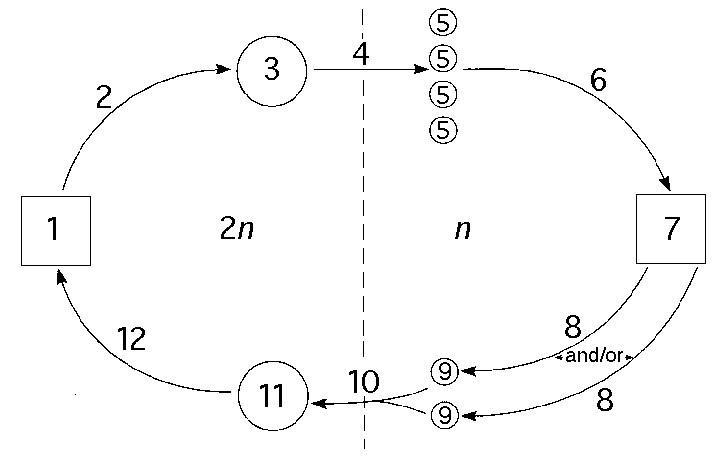
The following questions refer to the generalized life cycle for land
plants shown in Figure 30.1. Each number within a circle or square
represents a specific plant or plant part, and each number over an
arrow represents either meiosis, mitosis, or fertilization.
Figure 30.1
54) In Figure 30.1, which number represents the mature
gametophyte?
A) 1
B) 3
C) 5
D) 7
E) 11
D) 7
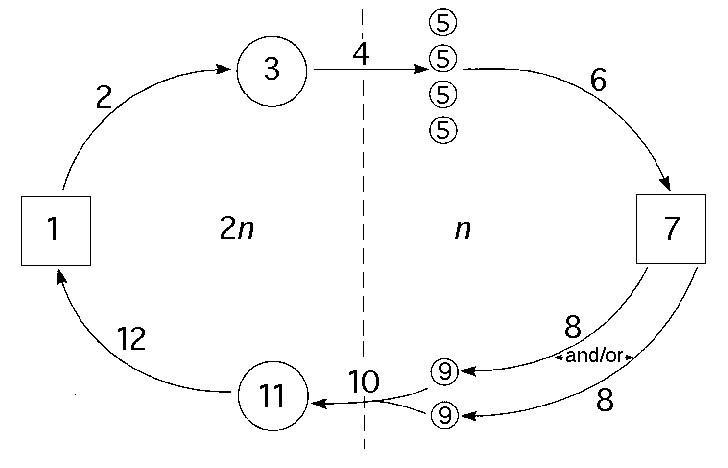
The following questions refer to the generalized life cycle for land
plants shown in Figure 30.1. Each number within a circle or square
represents a specific plant or plant part, and each number over an
arrow represents either meiosis, mitosis, or fertilization.
Figure 30.1
55) In Figure 30.1, which number represents an embryo?
A)
1
B) 3
C) 7
D) 9
E) 11
E) 11
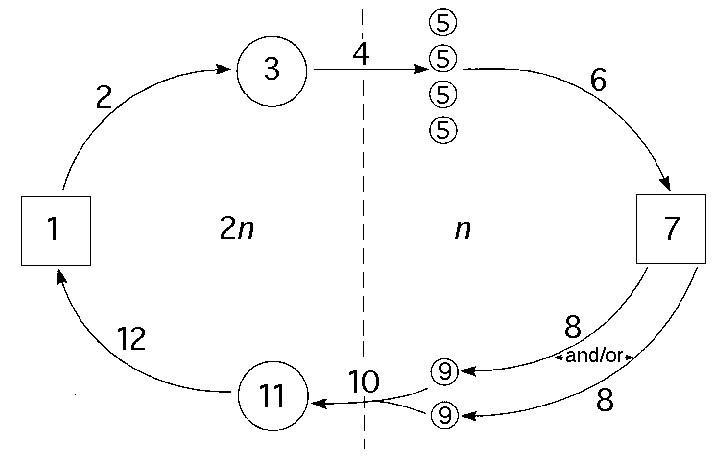
The following questions refer to the generalized life cycle for land
plants shown in Figure 30.1. Each number within a circle or square
represents a specific plant or plant part, and each number over an
arrow represents either meiosis, mitosis, or fertilization.
Figure 30.1
56) Meiosis is most likely to be represented by which number(s)
in Figure 30.1?
A) 2
B) 4
C) 2 and 8
D) 4 and
8
E) 10 and 12
B) 4
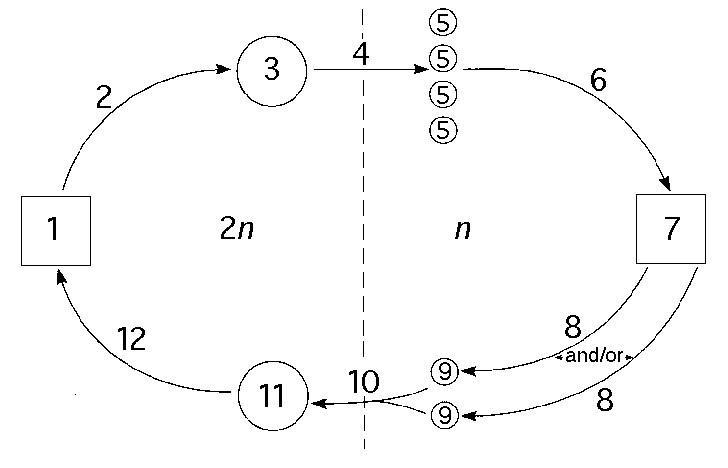
The following questions refer to the generalized life cycle for land
plants shown in Figure 30.1. Each number within a circle or square
represents a specific plant or plant part, and each number over an
arrow represents either meiosis, mitosis, or fertilization.
Figure 30.1
57) Which number represents a megaspore mother cell in Figure
30.1?
A) 1
B) 3
C) 5
D) 7
E) 11
B) 3
The following questions refer to the generalized life cycle for land
plants shown in Figure 30.1. Each number within a circle or square
represents a specific plant or plant part, and each number over an
arrow represents either meiosis, mitosis, or fertilization.
Figure 30.1
58) In Figure 30.1, the process labeled "6" involves
A) nuclear fission.
B) mitosis.
C) meiosis.
D)
fertilization.
E) binary fission.
B) mitosis.
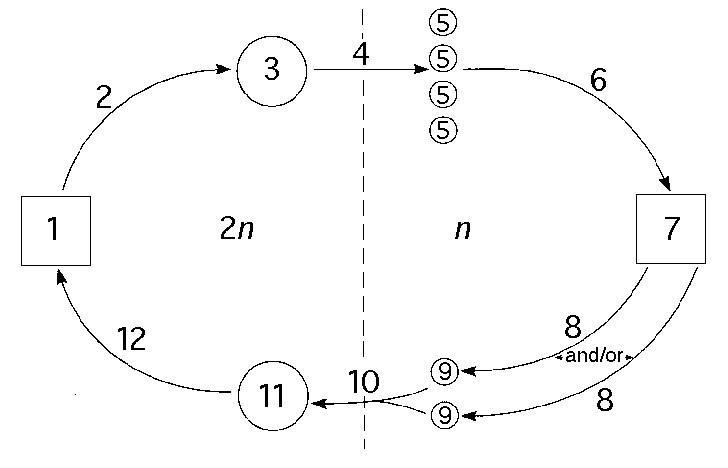
The following questions refer to the generalized life cycle for land
plants shown in Figure 30.1. Each number within a circle or square
represents a specific plant or plant part, and each number over an
arrow represents either meiosis, mitosis, or fertilization.
Figure 30.1
59) The embryo sac of an angiosperm flower is best represented
by which number in Figure 30.1?
A) 1
B) 3
C) 7
D) 9
C) 7
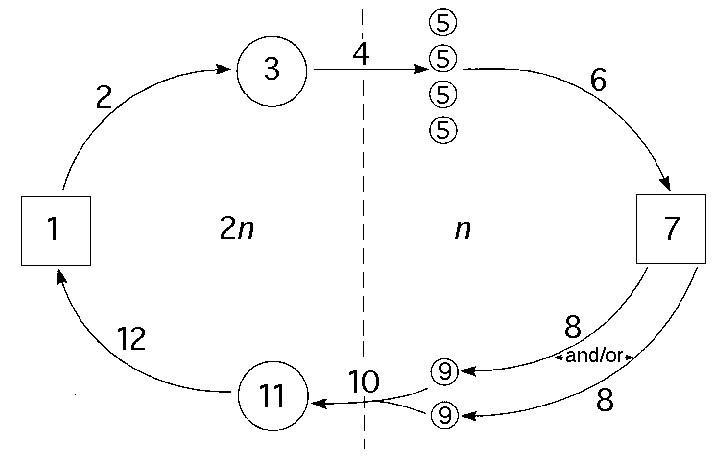
The following questions refer to the generalized life cycle for land
plants shown in Figure 30.1. Each number within a circle or square
represents a specific plant or plant part, and each number over an
arrow represents either meiosis, mitosis, or fertilization.
Figure 30.1
60) In angiosperms, which number in Figure 30.1 most nearly
represents the event that initiates the formation of endosperm?
A) 4
B) 6
C) 8
D) 10
E) 12
D) 10
The cycads, a mostly tropical phylum of gymnosperms, evolved about
300 million years ago and were dominant forms during the Age of the
Dinosaurs. Though their sperm are flagellated, their ovules are
pollinated by beetles. These beetles get nutrition (they eat pollen)
and shelter from the microsporophylls. Upon visiting megasporophylls,
the beetles transfer pollen to the exposed ovules. In cycads, pollen
cones and seed cones are borne on different plants. Cycads synthesize
neurotoxins, especially in the seeds, that are effective against most
animals, including humans.
62) Which feature of cycads makes them similar to many
angiosperms?
1. They have exposed ovules.
2. They have flagellated
sperm.
3. They are pollinated by animals.
A) 1 only
B) 2 only
C) 3 only
D) 2 and 3
E) 1, 2, and 3
C) 3 only
The cycads, a mostly tropical phylum of gymnosperms, evolved about
300 million years ago and were dominant forms during the Age of the
Dinosaurs. Though their sperm are flagellated, their ovules are
pollinated by beetles. These beetles get nutrition (they eat pollen)
and shelter from the microsporophylls. Upon visiting megasporophylls,
the beetles transfer pollen to the exposed ovules. In cycads, pollen
cones and seed cones are borne on different plants. Cycads synthesize
neurotoxins, especially in the seeds, that are effective against most
animals, including humans.
64) On the Pacific island of Guam, large herbivorous bats called
"flying foxes" commonly feed on cycad seeds, a potent source
of neurotoxins. The flying foxes do not visit male cones.
Consequently, what should be true?
A) The flying foxes are
attracted to cycad fruit, and eat the enclosed seeds only by accident.
B) Flying foxes are highly susceptible to the effects of the
neurotoxins.
C) The flying foxes assist the beetles as important
pollinating agents of the cycads.
D) Flying foxes can be
dispersal agents of cycad seeds if the seeds sometimes get swallowed
whole (in other words, without getting chewed).
D) Flying foxes can be dispersal agents of cycad seeds if the seeds sometimes get swallowed whole (in other words, without getting chewed).
Oviparous (egg-laying) animals have internal fertilization (sperm
cells encounter eggs within the female's body). Yolk and/or albumen is
(are) provided to the embryo, and a shell is then deposited around the
embryo and its food source. Eggs are subsequently deposited in an
environment that promotes their further development, or are incubated
by one or both parents.
74) The internal fertilization that occurs prior to shell
deposition is what type of angiosperm analog?
A) endosperm
B) pollen tube and sperm nuclei
C) carpels
D) fruit
E) integuments
B) pollen tube and sperm nuclei
Oviparous (egg-laying) animals have internal fertilization (sperm
cells encounter eggs within the female's body). Yolk and/or albumen is
(are) provided to the embryo, and a shell is then deposited around the
embryo and its food source. Eggs are subsequently deposited in an
environment that promotes their further development, or are incubated
by one or both parents.
75) The dispersal and/or nurture of young after hatching from
the egg is what type of angiosperm analog?
A) endosperm
B)
pollen tube and sperm nuclei
C) carpels
D) fruit
E) integuments
D) fruit
Harold and Kumar are pre-med and pre-pharmacy students, respectively.
They complain to their biology professor that they should not have to
study about plants because plants have little relevance to their
chosen professions.
77) From reading their biology textbook, what would Harold and
Kumar discover?
A) About one-quarter of all prescription drugs
come from seed plants.
B) Prescription drugs that enter the
water table are responsible for the extinction of many plants.
C) Much of what was once rain forest has been replanted with
fields of medicinally valuable plants.
D) All rain forest plants
contain at least one chemical useful as a medicine.
A) About one-quarter of all prescription drugs come from seed plants.
The Brazil nut tree, Bertholletia excels (n = 17), is native to
tropical rain forests of South America. It is a hardwood tree that can
grow to over 50 meters, is a source of high-quality lumber, and is a
favorite nesting site for harpy eagles. As the rainy season ends,
tough-walled fruits, each containing 825 seeds (Brazil nuts), fall to
the forest floor. About $50 million worth of nuts are harvested each
year. Scientists have discovered that the pale yellow,
self-incompatible flowers of Brazil nut trees admit only female orchid
bees as pollinators.
81) The agouti (Dasyprocta spp.), a cat-sized rodent, is the
only animal with teeth strong enough to crack the hard wall of Brazil
nut fruits. It typically eats some of the seeds, buries others, and
leaves still others behind inside the fruit, which moisture can now
enter. The uneaten seeds may subsequently germinate. Consequently,
which terms describe the relationship between the Brazil nut tree and
the agouti?
1. parasitic
2. commensalistic
3. symbiotic
4.
endosymbiotic
5. mutualistic
A) 1 and 3
B) 2 and 4
C) 2 and 5
D) 3 and 5
E) 4 and 5
D) 3 and 5
The Brazil nut tree, Bertholletia excels (n = 17), is native to
tropical rain forests of South America. It is a hardwood tree that can
grow to over 50 meters, is a source of high-quality lumber, and is a
favorite nesting site for harpy eagles. As the rainy season ends,
tough-walled fruits, each containing 825 seeds (Brazil nuts), fall to
the forest floor. About $50 million worth of nuts are harvested each
year. Scientists have discovered that the pale yellow,
self-incompatible flowers of Brazil nut trees admit only female orchid
bees as pollinators.
92) If a female orchid bee has just left a Brazil nut tree with
nectar in her stomach, and if she visits another flower on a different
Brazil nut tree, what is the sequence in which the following events
should occur?
1. double fertilization
2. pollen tube emerges from pollen
grain
3. pollen tube enters micropyle
4. pollination
A) 4, 2, 3, 1
B) 4, 2, 1, 3
C) 4, 3, 2, 1
D)
2, 4, 3, 1
E) 2, 4, 1, 3
A) 4, 2, 3, 1
100) With respect to angiosperms, which of the following is
incorrectly paired with its chromosome count?
A) egg–n
B) megaspore–2n
C) microspore–n
D)
zygote–2n
E) sperm–n
B) megaspore–2n
Which of the following is not a characteristic that distinguishes
gymnosperms and angiosperms from other plants?
A) alternation of
generations
B) ovules
C) integuments
D) pollen
E) dependent gametophytes
A) alternation of generations
Gymnosperms and angiosperms have the following in common except
A) seeds.
B) pollen.
C) vascular tissue.
D)
ovaries.
E) ovules.
D) ovaries.
If all fungi in an environment that perform decomposition were to
suddenly die, then which group of organisms should benefit most, due
to the fact that their fungal competitors have been removed?
A)
plants
B) protists
C) prokaryotes
D) animals
E) mutualistic fungi
C) prokaryotes
When a mycelium infiltrates an unexploited source of dead organic
matter, what are most likely to appear within the food source soon
thereafter?
A) fungal haustoria
B) soredia
C) fungal
enzymes
D) increased oxygen levels
E) larger bacterial populations
C) fungal enzymes
Which of the following is a characteristic of hyphate fungi (fungi
featuring hyphae)?
A) They acquire their nutrients by
phagocytosis.
B) Their body plan is a unicellular sphere.
C) Their cell walls consist mainly of cellulose microfibrils.
D) They are adapted for rapid directional growth to new food
sources.
E) They reproduce asexually by a process known as budding.
D) They are adapted for rapid directional growth to new food sources.
What do fungi and arthropods have in common?
A) Both groups are
commonly coenocytic.
B) The haploid state is dominant in both
groups.
C) Both groups are predominantly heterotrophs that
ingest their food.
D) The protective coats of both groups are
made of chitin.
E) Both groups have cell walls.
D) The protective coats of both groups are made of chitin.
In septate fungi, what structures allow cytoplasmic streaming to
distribute needed nutrients, synthesized compounds, and organelles
throughout the hyphae?
A) multiple chitinous layers in
cross-walls
B) pores in cross-walls
C) complex
microtubular cytoskeletons
D) two nuclei
E) tight
junctions that form in cross-walls between cells
B) pores in cross-walls
What accounts most directly for the extremely fast growth of a fungal
mycelium?
A) rapid distribution of synthesized proteins by
cytoplasmic streaming
B) a long tubular body shape
C) the
readily available nutrients from their ingestive mode of nutrition
D) a dikaryotic condition that supplies greater amounts of
proteins and nutrients
A) rapid distribution of synthesized proteins by cytoplasmic streaming
Immediately after karyogamy occurs, which term applies?
A)
plasmogamy
B) heterokaryotic
C) dikaryotic
D) diploid
D) diploid
Plasmogamy can directly result in which of the following?
1. cells with a single haploid nucleus
2. heterokaryotic
cells
3. dikaryotic cells
4. cells with two diploid nuclei
A) 1 or 2
B) 1 or 3
C) 2 or 3
D) 2 or 4
E) 3 or 4
C) 2 or 3
In most fungi, karyogamy does not immediately follow plasmogamy,
which consequently
A) means that sexual reproduction can occur
in specialized structures.
B) results in multiple diploid nuclei
per cell.
C) allows fungi to reproduce asexually most of the
time.
D) results in heterokaryotic or dikaryotic cells.
E)
is strong support for the claim that fungi are not truly eukaryotic.
D) results in heterokaryotic or dikaryotic cells.
Which process occurs in fungi and has the opposite effect on a cell's
chromosome number than does meiosis I?
A) mitosis
B)
plasmogamy
C) crossing over
D) binary fission
E) karyogamy
E) karyogamy
Which of the following statements is true of deuteromycetes?
A)
They are the second of five fungal phyla to have evolved.
B)
They represent the phylum in which all the fungal components of
lichens are classified.
C) They are the group of fungi that
have, at present, no known sexual stage.
D) They are the group
that includes molds, yeasts, and lichens.
E) They include the
imperfect fungi that lack hyphae.
C) They are the group of fungi that have, at present, no known sexual stage
Fossil fungi date back to the origin and early evolution of plants.
What combination of environmental and morphological change is similar
in the evolution of both fungi and plants?
A) presence of
"coal forests" and change in mode of nutrition
B)
periods of drought and presence of filamentous body shape
C)
predominance in swamps and presence of cellulose in cell walls
D)
colonization of land and loss of flagellated cells
E)
continental drift and mode of spore dispersal
D) colonization of land and loss of flagellated cells
Which of the following characteristics is shared by both chytrids and
other kinds of fungi?
A) presence of flagella
B) zoospores
C) autotrophic mode of nutrition
D) cell walls of
cellulose
E) nucleotide sequences of several genes
E) nucleotide sequences of several genes
The multicellular condition of animals and fungi seems to have arisen
A) due to common ancestry.
B) by convergent evolution.
C) by inheritance of acquired traits.
D) by natural means,
and is a homology.
E) by serial endosymbioses.
B) by convergent evolution.
You are given an organism to identify. It has a fruiting body that
contains many structures with eight haploid spores lined up in a row.
What kind of a fungus is this?
A) zygomycete
B) ascomycete
C) deuteromycete
D) chytrid
E) basidiomycete
B) ascomycete
Arrange the following from largest to smallest, assuming that they
all come from the same fungus.
1. basidiocarp
2. basidium
3. basidiospore
4.
mycelium
5. gill
A) 4 → 5 → 1→ 2 → 3
B) 5 → 1 → 4 → 2 → 3
C) 5 → 1 →
4 → 3 → 2
D) 5 → 1 → 3 → 2 → 4
E) 4 → 1 → 5 → 2 → 3
E) 4 → 1 → 5 → 2 → 3
A fungal spore germinates, giving rise to a mycelium that grows
outward into the soil surrounding the site where the spore originally
landed. Which of the following accounts for the fungal movement, as
described here?
A) karyogamy
B) mycelial flagella
C)
alternation of generations
D) breezes distributing spores
E) cytoplasmic streaming in hyphae
E) cytoplasmic streaming in hyphae
) Both fungus-derived antibiotics and hallucinogens used by humans
probably evolved in fungi as a means to
A) reduce competition
for nutrients.
B) help humanity survive.
C) promote their
ingestion of foodstuffs.
D) eliminate other fungi.
E)
discourage animal predators.
A) reduce competition for nutrients
Orchid seeds are tiny, with virtually no endosperm and with miniscule
cotyledons. If such seeds are deposited in a dark, moist environment,
then which of the following represents the most likely means by which
fungi might assist in seed germination, given what the seeds lack?
A) by transferring some chloroplasts to the embryo in each seed
B) by providing the seeds with water and minerals
C) by
providing the embryos with some of the organic nutrients they have absorbed
C) by providing the embryos with some of the organic nutrients they have absorbed
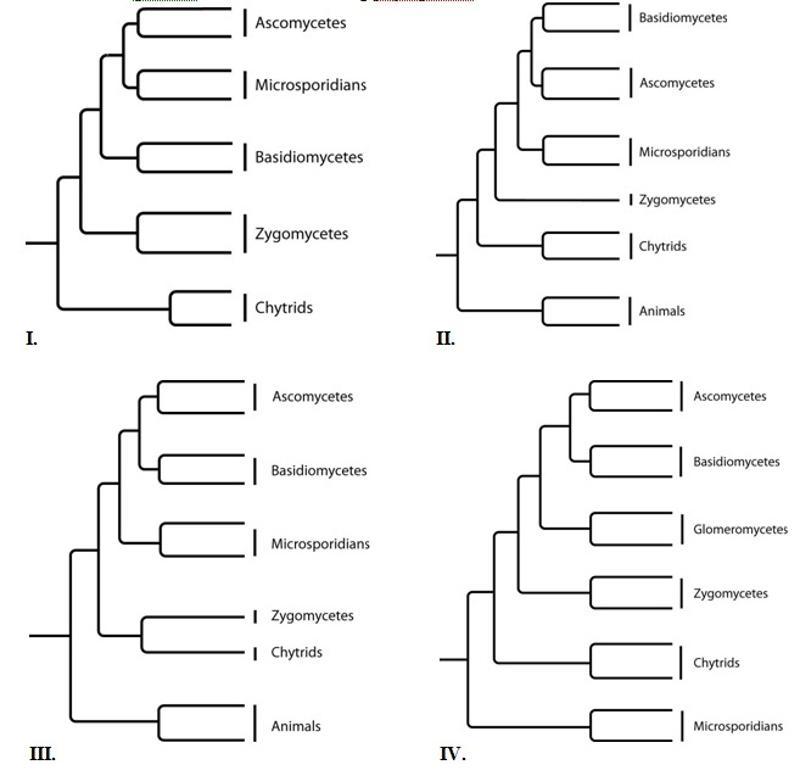
49) Which tree depicts the microsporidians as a sister group of the
ascomycetes?
A) I
B) II
C) III
D) IV
A) I
asc
mic
bus
zy
chy
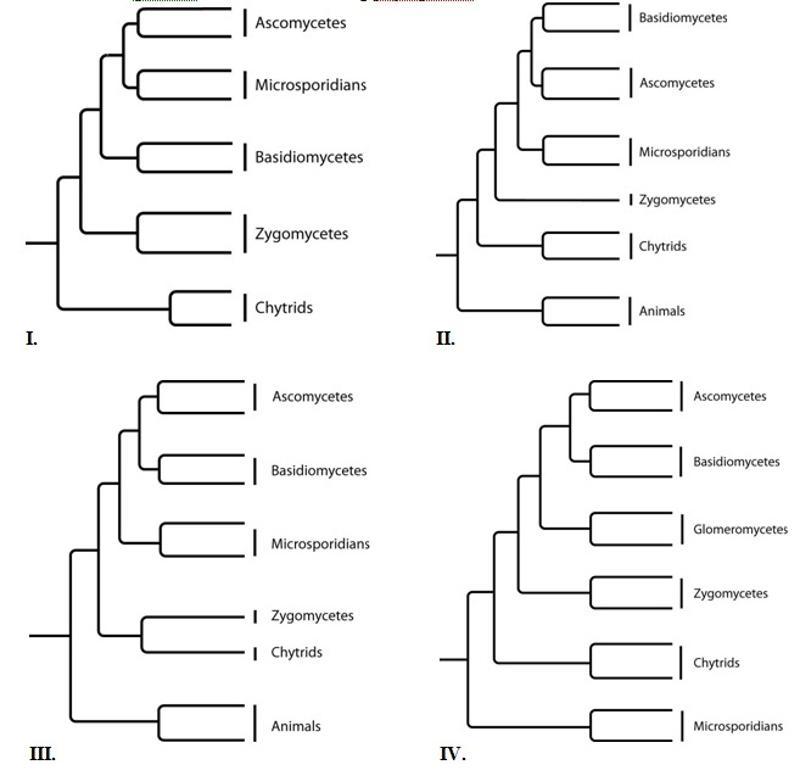
Which tree depicts the microsporidians as a sister group of the
fungi, rather than as a fungus?
A) I
B)
II
C) III
D) IV
D) IV
as
bas
gi
zy
ch
cm
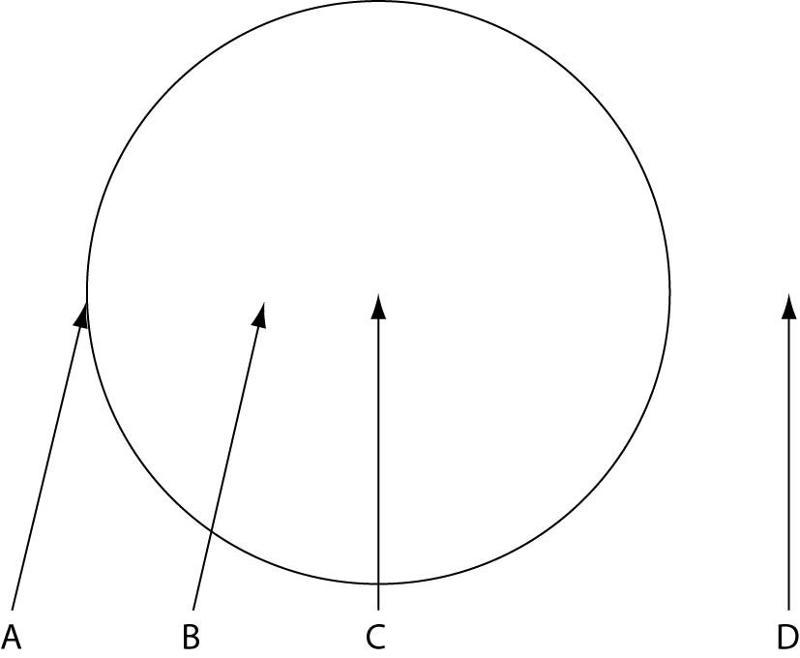
The following figure depicts the outline of a large fairy ring that
has appeared overnight in an open meadow, as viewed from above. The
fairy ring represents the furthest advance of this mycelium through
the soil. Locations AD are all 0.5 meters below the soil surface.
Responses may be used once, more than once, or not at all.
52) What is the most probable location of the oldest portion of
this mycelium?
A) A
B) B
C) C
D) D
C) C
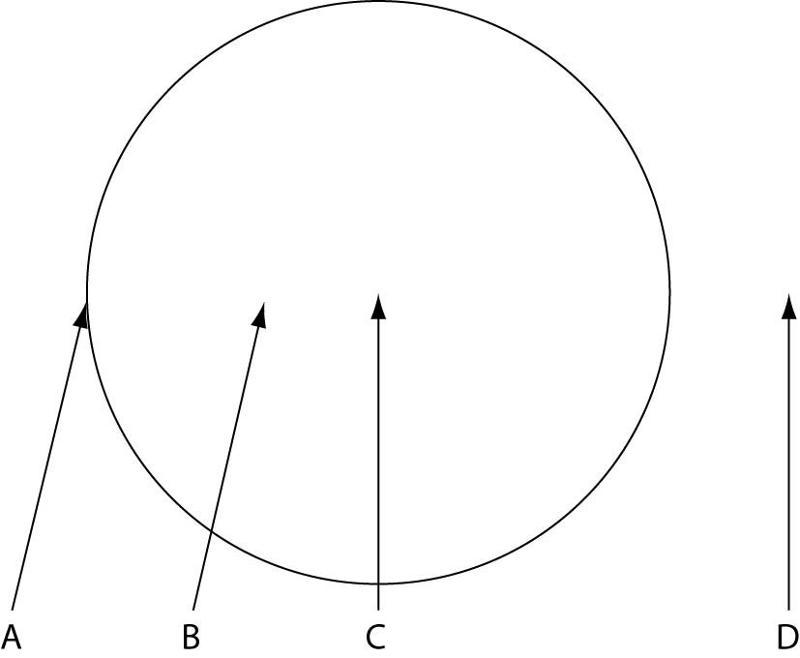
The following figure depicts the outline of a large fairy ring that
has appeared overnight in an open meadow, as viewed from above. The
fairy ring represents the furthest advance of this mycelium through
the soil. Locations AD are all 0.5 meters below the soil surface.
Responses may be used once, more than once, or not at all.
54) At which location is the mycelium currently absorbing the
most nutrients per unit surface area, per unit time?
A) A
B) B
C) C
D) D
A) A
The following figure depicts the outline of a large fairy ring that
has appeared overnight in an open meadow, as viewed from above. The
fairy ring represents the furthest advance of this mycelium through
the soil. Locations AD are all 0.5 meters below the soil surface.
Responses may be used once, more than once, or not at all.
57) In which of the following human mycoses should one expect to
find a growth pattern most similar to that of the mycelium that
produced the fairy ring?
A) skin mycoses
B)
coccidiomycosis (lung infection)
C) systemic (bloodborne)
Candida infection
D) Sporothrix infection of lymphatic vessels
E) Tinea tonsurans infection limited to interior of hair shafts
A) skin mycoses
Surface area represents the area available for exchange with the
environment, whereas volume represents the cytoplasm which requires
nutrients and from which waste products (usually toxic) must be
removed. Which of the following should provide the most favorable
conditions for effective exchange?
A) a smaller unicellular
yeast
B) a larger unicellular yeast
C) a shorter
filamentous hypha
D) a longer filamentous hypha
D) a longer filamentous hypha
Some fungi can exist either as unicellular yeasts or as filamentous
hyphae. Which of these forms would be most favorable in an environment
where nutrients are limited?
A) a smaller unicellular yeast
B) a larger unicellular yeast
C) a shorter filamentous
hypha
D) a longer filamentous hypha
D) a longer filamentous hypha
For several decades now, amphibian species worldwide have been in
decline. A significant proportion of the decline seems to be due to
the spread of the chytrid fungus, Batrachochytrium dendrobatidis (Bd).
Chytrid sporangia reside within the epidermal cells of infected
animals, animals that consequently show areas of sloughed skin. They
can also be lethargic, which is expressed through failure to hide and
failure to flee. The infection cycle typically takes four to five
days, at the end of which zoospores are released from sporangia into
the environment. In some amphibian species, mortality rates approach
100%; other species seem able to survive the infection.
74) Sexual reproduction has not been observed in Bd. If its
morphology and genetics did not identify it as a chytridiomycete, then
to which fungal group would Bd be assigned?
A) ascomycetes
B) zygomycetes
C) glomeromycetes
D) basidiomycetes
E) deuteromycetes
E) deuteromycetes
Rose-picker's disease is caused by the yeast, Sporothrix schenkii.
The yeast grows on the exteriors of rose-bush thorns. If a human gets
pricked by such a thorn, the yeasts can be introduced under the skin.
The yeasts then assume a hyphal morphology and grow along the
interiors of lymphatic vessels until they reach a lymph node. This
often results in the accumulation of pus in the lymph node, which
subsequently ulcerates through the skin surface and then drains.
83) Humans have immune systems in which lymph nodes are
important, because many phagocytes and lymphocytes reside there. Given
that a successful infection by S. schenkii damages lymph nodes
themselves, which of the following is most probable?
A) The
hyphae secrete antibiotics, which increases the ability of the
infected human to tolerate the fungus.
B) Their conversion from
yeast to hyphal morphology allows such fast growth that the body's
defenses are at least temporarily overwhelmed.
C) Defensive
cells of humans cannot detect foreign cells that are covered with cell
walls composed of cellulose.
D) Given that most fungal pathogens
attack plants, human defenses are simply not adapted to seek out and
destroy fungi.
E) Given that most fungal pathogens of humans
infect only the skin, human defenses are not adapted to seek out and
destroy systemic fungal infections.
B) Their conversion from yeast to hyphal morphology allows such fast growth that the body's defenses are at least temporarily overwhelmed.
All fungi share which of the following characteristics?
A)
symbiotic
B) heterotrophic
C) flagellated
D)
pathogenic
E) act as decomposers
B) heterotrophic
Which feature seen in chytrids supports the hypothesis that they
diverged earliest in fungal evolution?
A) the absence of chitin
within the cell wall
B) coenocytic hyphae
C) flagellated
spores
D) formation of resistant zygosporangia
E)
parasitic lifestyle
C) flagellated spores